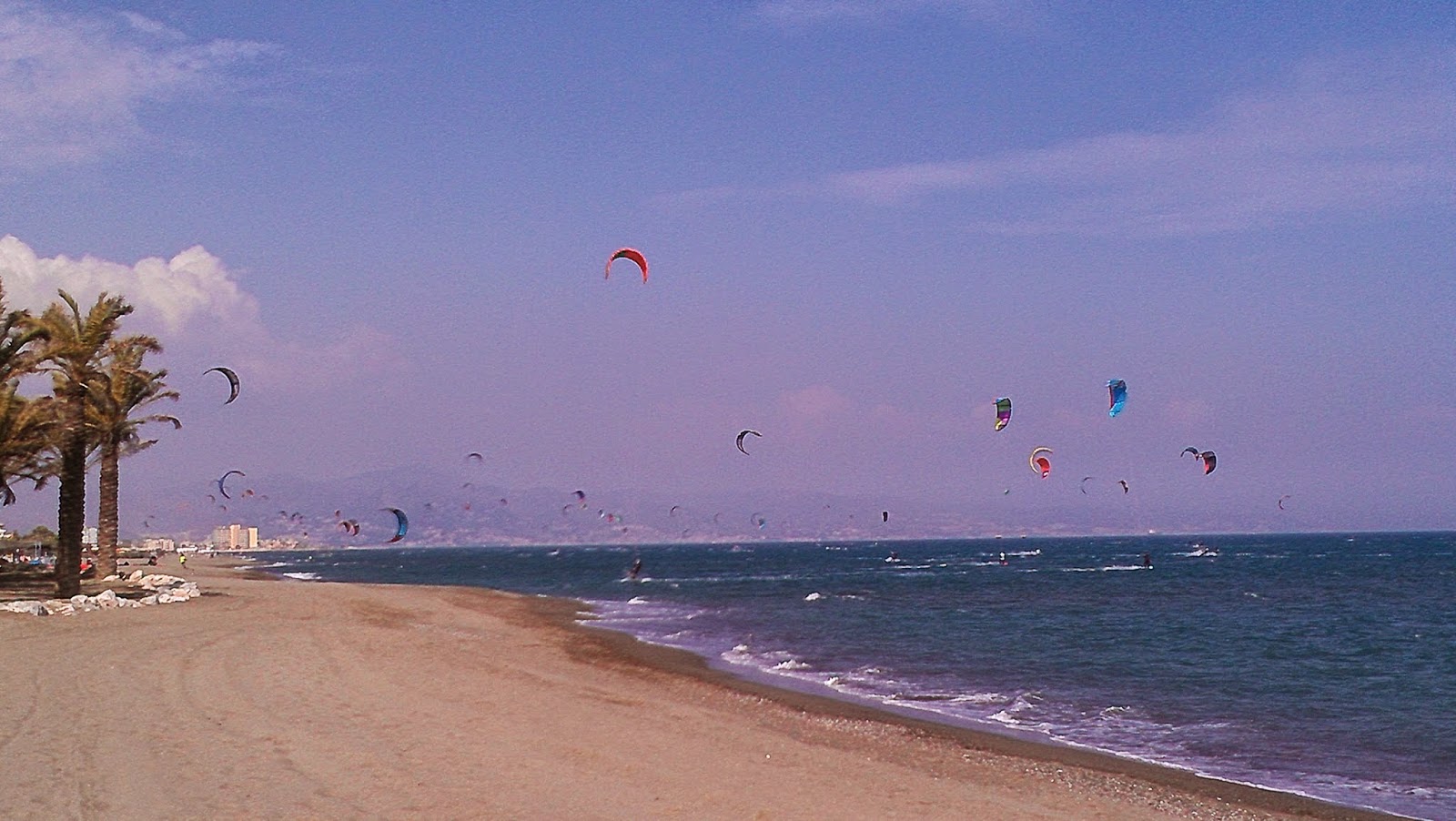How I Lost over 15 Pounds While Living in Spain (and Eating Everything!)
Wow! You look great!Hey skinny lady!
Who’s that in the picture?
It almost never fails. Every time I post a pic of myself on Facebook or some other social media outlet, these are the comments I get from friends and family back home. Since first moving to Spain for a 6-month stint in 2014, and after living here for almost another 8 months, I’ve lost quite a bit of weight. I’ve never been one to track my weight (scales, schmales), so I’m not exactly sure how much I’ve lost (that 15lbs in the title was really just a guesstimate); but I do know that not only have I dropped a couple of dress sizes, I also feel a lot better about my body – the way it looks, feels, and how it serves me as I go about my daily business. And get this: I’ve never once been to the gym.
Before I have you thinking that I’ve slimmed down to the point of having no body issues at all, let me tell you: I’ve still got quite a little pooch going on, I still have minor anxiety sporting a two-piece on a beach full of super-fit Europeans, and, at over 35 years old, I’ve got bits that are jiggling and swaying way more than they ever did (or should). Still, more often than not, I like what I see looking back at me when I look in the mirror, and I know for certain that it has a lot to do with abandoning my American eating and living habits and adopting a more Spanish or European lifestyle. Namely:
Smaller restaurant portions
Though I eat all the things I try to avoid when eating out at home – like taters, bread, and pasta – and I drink like there’s no tomorrow, I’ve still managed to shed pounds. Part of this is because the amount of these things that I consume in a sitting is much less than what I’d consume in the States. The US is notorious for its ridiculous portion sizes. If you order a meal for one in a typical US dining establishment, you’re usually presented with enough food for 2 people. Ditto for drinks – especially sodas and beers. Here in Spain, the tradition of tapas – or small plates of food that are meant to be eaten in a few bites – makes it easy to have a filling meal with lots of variety, yet not overeat. One of my favorite Spanish portion control options is the caña – which is basically a half-sized serving of beer. Even when I go out and have multiple rounds of beers, I’m still only drinking half as much as I would if I did the same in the States.
Several small meals a day
My typical daily eating pattern in Spain goes something like this…
For breakfast (before 11am): Coffee and/or water.
Post-breakfast / Pre-lunch (between 11am and 2pm): A piece of fruit or, occasionally, a small pastry or slice of Spanish tortilla.
For lunch (between 2 and 3pm): A quick, home-cooked meal like a pasta dish, a big salad, or a meat-and-veggie dish.
Post-lunch: A piece of fruit or two for an after-lunch dessert or snack.
For dinner (between 8 and 10pm): A couple of rounds of drinks and accompanying free tapas or another quick, home-cooked meal.
I’ve adopted this pattern of eating after observing and eventually falling in line with the way I’ve seen the folks around me eat. The concept of eating several small meals a day isn’t unique to Spain. In fact, most nutritionists and weight loss experts in the US recommend this method of eating. Still, it isn’t the norm for the average American. We’ve been indoctrinated with the idea that you should eat ‘3 square meals’ a day – a hearty breakfast, a hearty lunch, and an especially hearty dinner – and that’s pretty much how I used to eat back home (with the exception of the hearty breakfast). Here, lunch – not dinner – is often the biggest meal of the day, which leaves plenty of time to burn off the calories before settling in for the evening.
Lunch at home
You’ve probably heard of the Spanish siesta – that 2-3 hour lull in the middle of the day where everything shuts down and people go home to take a nap. While not everyone actually takes a nap during that time, almost everyone I know goes home for a home-cooked lunch. Having that large block of time to go home, prepare a healthy meal, eat it like a normal human (versus inhaling it like a vacuum cleaner), and let it digest a bit before heading back to work, is a luxury that I wish I had in the US. At home, I would barely have time to stuff some chicken fingers and fries (or a similarly unhealthy option) from the downstairs food court into my gullet before heading off to a meeting or rushing to meet an end-of-day deadline. Even on the days when I did go for a healthier lunch option, it was often more expensive to do so, and I’d end up resorting to the cheaper, less healthy lunch the very next day.
Coffee done right
Coffee is a known metabolism booster, and can help you burn extra calories IF you drink it the right way. What’s the right way? Well, ditching all the milk and sugar (I’m lookin’ at you, Starbucks), and drinking a small amount of black coffee or coffee with very little milk and sugar (like my beloved cortado) is a start. Also, it’s typical in Spain to have a coffee directly after or between meals, which is just when your body benefits from an extra boost of metabolism to help burn off the food you recently consumed.
Shared meals
In Spain, especially in smaller cities like the one I live in, eating is not a solo sport. Meals are meant to be shared – with friends, family members, coworkers, roommates. When you go out to eat with a group, it’s typical for everyone to share from common plates or to share bites of their individually ordered dish with everyone else at the table. At first, I turned my nose up at this practice. But… I want all my food for myself! But, I’m still hungry! But over time, I’ve adjusted. I’ve even noticed that the slower pace of eating in a group setting, helps me feel more full with less food. I’ve also noticed that Spaniards tend to share snack foods with folks around them. Whenever one of my colleagues has what we Americans would consider a single serving bag of chips or a similar snack, they always end up offering away at least a third of it to others, or eating about half and saving the rest for another time.
Walking
When I lived in the States, my work kept me sitting at a desk for multiple hours a day. After work, I’d walk 2 minutes to get in my car and drive home, where I’d often do more work sitting at a computer, before cooking dinner and watching TV or reading for a couple of hours before bed. Even if I ran errands in the neighborhood – like going to the grocery store that’s literally at the end of my street – it meant getting into my car and driving there. In the US, walking is often seen as a hardship or something that the less fortunate (i.e., those who can’t afford cars) do. The combination of a car-centric culture, and sprawling cities and neighborhoods, make walking for anything other than intentional exercise either unfashionable or implausible.
To put things in perspective, the entire country of Spain is smaller than the state of Texas (in square miles). The lack of sprawl makes walking a lot more feasible. Neighborhoods are designed so that you have almost everything you need within walking distance of your home – grocery stores, banks, schools, retail shops, personal services. And you’re not seen as odd or less fortunate if you walk everywhere, because almost everyone else – from infant to elderly – is walking too.
Water, water, everywhere
Because of all the walking I do, and because of a personal commitment to myself to consume more water, I almost always have a bottle of water on hand. I keep a 5L bottle of water in my room by my bedside, so I can not only track roughly how much water I drink a day, but also so I never have to go far to get it.
Biking
This is probably the single most influential factor in my weight loss. At the beginning of this school year, one of the professors at my high school was kind enough to loan me a bike to use during my time here. It just so happens that this bike is the oldest specimen of 2-wheeled locomotion ever known to man. It’s also a fixed gear, and it can leave my legs feeling like jelly even when riding on relatively flat terrain. Still, it’s a more efficient mode of transportation than walking, and I ride my rusty steed everywhere – to school, to the grocery store, to the park, to the library. I usually spend around 30-40 minutes biking each day, which isn’t a lot, but it’s definitely made a lot of difference.
Easy access to healthy, cheap ingredients
Within a 3-5 minute walk in any direction from my apartment, I have a least 4 independently owned fresh fruit/veggie stands, and 2-3 chain grocery stores. The selection of produce in either of those outlets is generally less varied than what I’d find in the US, but the price and the quality is significantly better. And the fact that they’re so close and right in front of my face, makes it easier for me to grab a healthy snack versus the fast food that I’d normally go for back home.
Fast food as an occasional treat
In the US, fast food is convenience food. Don’t have time to cook? Forgot to pack a healthy lunch? No problem. Just stop by one of the dozen fast food restaurants you’re sure to pass on your way to and from home and pick up an extremely high-calorie, extremely low cost meal. Fast food is so widely available and frequently consumed in the US, it could almost be considered its own food group. While I wasn’t a frequent consumer of fast food at home, I certainly ate my fair share of quick-serve lunches at work, and my go-to snack when on the run was an order of french fries from the nearest Chik-Fil-A or McDonald’s. Here, a trip to a fast food outlet is seen as a treat – something you do every once in a while as a special outing for the kids or yourself. And the prices reflect that. Going to Mickey D’s, KFC or Burger King is often an expensive proposition – a combo meal can run from 5 to 7 euros, and there’s rarely, if ever, a dollar menu. There are also fewer fast food locations to choose from. You almost have to go out of your way to get to one, and you’ll have to pass several cheaper, considerably healthier options to do so.
Now, are any of the above behaviors impossible to duplicate in the US? Absolutely not. Am I suggesting that there are no overweight or obese Spaniards? Nope. In either country, individual health and body weight are often a reflection of the daily lifestyle choices we make. But due to cultural norms, I think it’s more difficult to make these choices and stick to them on a regular basis back home in the US of A. As my time in Spain comes to an end, I often worry if I’ll be able to hold on to these healthy habits that I’ve picked up in my host country. I like to think that it’ll be easy, but I’m not 100% sure. For my own sake, and for the sake of my Facebook photo admirers, I certainly hope so. :)
Have you noticed any positive body changes during your travels or time living abroad? What do you think was behind it? Have you been able to stick to your healthy habits after returning to your home country?
Share your feedback in the comments!
7 reasons you shouldn’t couchsurf if you haven’t already

Ok. So you’ve heard about Couchsurfing (CS) from a friend of a friend or an article in a travel magazine or around a campfire that one time when you ran into a band of wandering hippies. You may even be thinking of trying it out for yourself. I’m a big fan of both the concept and the reality of Couchsurfing – I’ve used it at least 4 times in 4 different countries (all while travelling solo), and each of my experiences has been amazing. I’d even go so far as to say that my Couchsurfing experiences have renewed my faith in the kindness and hospitality of my fellow upright bi-pedders.
But I also realize that Couchsurfing is not for everyone. It’s not intended to be. And that’s ok. So, if you’re on the fence about Couchsurfing, here are 7 reasons that may (or may not) convince you to book a hotel instead.
#1: Don’t Couchsurf if you don’t personally know someone who has surfed or hosted.
Couchsurfing sounds strange and scary, especially for us Americans. What if this person kills me? Robs me? Rapes me? Makes me listen to Enya all night long? Having a friend or associate who has Couchsurfed before will give you the chance to ask all the questions you want and have your suspicions and fears put at ease before you ever go looking for a host or guest. If this person knows you well, they’ll be better equipped to help you figure out if Couchsurfing is something that fits your personal needs and tastes. Plus, an experienced Couchsurfer will be able to school you on all of the unwritten rules and customs that are common among CS’ers.
#2: Don’t Couchsurf if you’re just looking for a free room.
Yes. If you find a Couchsurfing host, you will be able to stay at his/her place without paying a red cent. But this isn’t just about what you get out of the situation, it’s also about what you’re willing to give – namely, some of your time, personality, and life experiences. Couchsurfers are all about meeting and getting to know people from all over the world. Many of them have learned second languages, discovered new music, tried new foods, or planned their next vacation to previously unheard of destinations just from the interactions they’ve had with fellow surfers. The goal is to build relationships, not just freeload at someone’s house. It’s even common to bring a little gift or token of appreciation for your host – a bottle of wine, a fridge magnet from your home country or state, or any little thing that says, ‘thanks for letting this stranger sleep in your house’.
#3: Don’t Couchsurf if you’re not prepared to do some upfront work.
Nothing in life is truly free. This applies even to Couchsurfing. In order to have a quality Couchsurfing experience, you’re going to need to spend a lot of time thoroughly filling out your CS profile. The more thorough, honest, and detailed your profile is, the more likely you’ll be able to find someone with similar interests or a compatible outlook on life. Once you’re ready to look for a host, you’ll also need to put in quite a lot of time perusing potential hosts’ profiles, going over all of the feedback that previous guests have given, sending couch requests, waiting for replies, etc. I liken the whole CS reservation request experience to looking for a match on a dating or friend site. It takes time to get quality results. You should also be prepared to leave detailed and useful feedback about your host after your stay – it’s this contribution that helps the next person decide if they should follow in your footsteps.
#4 - Don’t Couchsurf if you don’t have a Plan B.
At the end of the day, you’re dealing with someone you don’t know. Even if you’ve done all of your pre-work and feel comfy with your host, shit happens. Maybe your host will need to cancel at the last minute. Maybe you won’t like the vibe you get when you get there. Whatever the reason, always have a backup plan – another nearby hotel or hostel you can head to if need be, and enough money to pay for a more traditional living arrangement should the need arise.
#5 - Don’t Couchsurf if you don’t like sharing or if you have an inherent mistrust of strangers or the internet.
By its very nature, CS is more suitable for open-minded, gregarious people who don’t mind sharing a little bit about themselves on the internet (i.e., your CS profile) or with people they’ve never met before. If you already know that’s not your style, don’t stress yourself or other CS’ers out.
#6 - Don’t Couchsurf if you’re just looking to hook up or get laid.
Unfortunately (or fortunately, depending on your stance on the issue),
think that CS is the perfect way to get easy sex with strangers. To each his or her own, I say. But, if that’s all you’re looking for, there are plenty of other sites out there that are more suited for that purpose. If you somehow feel like you MUST use CS to achieve your sex-with-strangers fantasy, at least be upfront about your intent with potential guests / hosts, and be prepared for the other person not being on the same page. Full disclosure: I’ve messaged potential hosts who responded with messages that made it clear that their intent or interest would be to engage in some physical recreation with me. While it creeped me out a bit, I was mostly relieved that they were upfront about their intent. I politely declined their offer, and kept searching for a more suitable host. No harm, no foul.
#7 - Don’t Couchsurf if the little voice tells you not to.
As a frequent solo traveler, I’ve learned that one of the best tools in my nomad toolkit is my intuition, aka, the little voice. If you have even the slightest hint of uneasiness or a feeling that something might not be right with a potential Couchsurfing situation, don’t go into it. At the end of the day, you’re travelling to have a good experience, you are under no obligation to suffer discomfort or weirdness even if you’re staying with someone for free.
Have you Couchsurfed before? What have your experiences been like? Still not sure if Couchsurfing is for you? What are some of your concerns or worries?
Share your feedback in the comments!
my travel style, aka, how I travel on the cheap in spain
Since I’m in the habit of giving advice and tips about the places I’ve traveled to on this blog, I thought it was worthwhile to share some more information on exactly the type of traveler I am. Travel advice is really only relevant if the receiver has similar travel interests and preferences as the person giving the advice. For instance, some people would never stay in a hostel or
, while others – like myself – usually steer clear of chain hotels and all-inclusives. So, with that, here’s some insight into my personal travel style, so you can decide for yourself whether my travel advice is suitable for you.

I live cheaply when not travelling
– I live in a pretty small town in the interior of Spain, so most things here are cheaper than they are elsewhere in the country. My major expense – rent – runs me about 150 euros a month, and that includes all of my utilities. I share an apartment with 3 other ladies – a fairly common arrangement in Spain, even for working professionals – so that helps to keep costs low. Even when I lived on my own, rent and utilities averaged 275 euros a month – extremely cheap by American standards. I eat out, but not too often. When I do, it’s usually at a place where I buy a beer or a glass of wine and get a free tapa. At the grocery store, I buy very few packaged goods – which are typically more expensive than whole foods – choosing veggies, fresh fruits, fish, and meats instead of heat-and-serve meals. I also don’t waste leftovers. I remix them until they’re all gone.
Blablacar
– I describe
as a safer way to hitchhike. I tend to use it for short to mid-distance trips to nearby cities or provinces (roughly, 4 hours or less). Using the site or app, you can search for drivers who are leaving from your area and heading to a destination you want to go to. The drivers offer available seats in their car for a much, much lower price than a train or even a bus. An added benefit is that you get the chance to chat with a local about any number of things, including their recommendations on what you should see and do when you reach your destination.
SpainPass – Like much of Europe, Spain’s long distance train system is quite good. The trains are reliable and fast, and depending on how early you buy your ticket, they can also be quite affordable. I tend to use trains for exploratory, long-distance trips. Renfe – Spain’s national train service – offers a very attractive multi-trip pass for non-Spanish travelers. It’s called SpainPass, and it allows you to travel multiple legs on the train for about 40 euros per leg. The only catch is that all trips must be paid for upfront, and they must all be used in 30 days. Because of the time limit, I try to use this option strategically. For instance, in December, there was both a long holiday at the beginning of the month and the Christmas holidays at the end of the month. Using SpainPass, I was able to travel to Valencia, Malaga, and Barcelona that month for much less than plane tickets or regular-price train tickets. Whenever I use SpainPass, I typically search for a destination that would cost me a lot of money to get to and go there.

Skyscanner
– Simply the best app or flight search site I’ve found for showing the lowest prices to my chosen destination. There’s enough flexibility in
search function for me to select a departure location and leave the destination open, which allows me to see where I can fly to for the least amount of money.
Pack light
– when I don’t travel via train or Blablacar, I’m usually on one of what I call ‘ghettoeurope’ airlines –
or
. These super low-cost airlines are able to keep their prices low because they offer a no-frills service. This is especially true when it comes to baggage restrictions. Both of these airlines only allow you to travel with a small carry-on bag for free. While the luggage size isn’t restrictively small, it may take some smart packing to keep from having a too-large bag that costs you more money.
Hostels
– Unfortunately, this is one way I could probably travel even more cheaply. But, since I’m over 35 and my dorm room days are decades behind me, I find it hard to stomach the idea of a communal bathroom, and I simply can’t wrap my head around the idea of sleeping in a room with strangers. I mean, what if I need to poot, scratch, rub one out? Now, I
have
stayed in hostels, but I always opt for the private room option when I do – it’s more expensive than the traditional hostel experience, but still much cheaper than a standard hotel.
Home stays – I do, however, love Couchsurfingand Airbnb – two options for staying in a home or apartment while travelling. Usually there’s a kitchen I can use to cook a quick meal or even just have some fruit, bread, and cheese for breakfast or a snack.

one of my most unique and enjoyable homestays - a hammock on a houseboat in amsterdam
Eat out only for the main meal
– I’m a foodie, so I definitely like to eat out when I’m travelling – but I try to eat out for my main meal of the day – typically late lunch or dinner – and just eat fruit or snacks purchased at a local supermarket for the other meals. I also try to save dining out experiences for iconic dishes or local specialties, not just because I’m hungry and need a bite.
Public transportation
– Most cities in Spain are very walkable, but when my feet get tired, I opt for public transportation, not taxis or car hires. Not only is public transport cheaper, it’s also a good way to quickly get a feel of the layout of the city and what the people are like.
No tours
– I just don’t believe in paying for them. And since I’m not one who feels like I need to see EVERYthing when I visit a place – I typically pick out 2 or 3 must-sees, and let the rest happen as it may – tours aren’t really worth my money. Also, since I stay with locals, there’s no need for a tour. A quick conversation with my host about what I’m looking for and how to get there, and it’s like I’ve received a customized itinerary. However, there are occasionally
.
Skip paid attractions
– Again, there are some rare occasions when I’ll make an exception to this rule. But for the most part, I skip any site that I have to pay to enter. This includes museums and theme parks. I prefer parks, neighborhoods, plazas, local markets, and other outdoor activities as they give me more of a feel for what the city and its people are like.
What are some of your tips for keeping costs low while travelling in Spain, Europe, or elsewhere in the world? Share them in the comments!
how to do barcelona
I’ll admit it. I’m kind of addicted to this town. Maybe it’s because it was the first Spanish city I visited on my own. Maybe it’s because my first visit was the very definition of serendipity. Or maybe it’s because Barcelona is the one city in Spain that I know I can go to to satisfy all my cravings of home. In my opinion, Barna (not Barça - that abbreviation is specifically reserved for the football club) is the most metropolitan city in Spain, even more so than the capital of Madrid, and that’s because Barcelona has something that I think Madrid lacks – soul. Since that first visit just a little over a year ago, I’ve been back to the Catalonian capital 4 times, and it’s only a matter of time before I go again.
After those 5 visits, here are some of my favorite ways to ‘do’ Barcelona.
How to Do Barcelona: Take a Hop-On, Hop-Off Bus Tour
Yes, yes, I know. What sort of insider’s guide starts with, ‘book a tour’? I’m usually not a fan of tours, since I think it’s useless trying to pack in too much sightseeing in a single trip, and I prefer finding (and sometimes losing) my own way. But, there are some cities – such as London and Barcelona – that have so many different sites of interest spread out over such a large area, that I think it’s not only worth paying the price for a tour, it’s also worth saving yourself from aching feet and the frustration of trying to locate even your very top must-see sites using public transportation. My personal advice when booking a HOHO tour in Barna is this: Start early, then stay on the bus for a full loop (yes, it will be hard to resist getting off for photo opps, but do it) before you disembark anywhere. This will allow you get the tourist version of a sampler platter – a little taste of all that the city has to offer – before deciding which places you’d like to hop off at and delve deeper into. Barcelona’s most popular HOHO bus tour is the
, and it’s the one I recommend. Some of my favorite places to hop off for a more up-close look include:
– You simply can’t visit Barcelona without seeing this impressive outdoor space designed by Antonio Gaudí. While you have to pay for up-close access to some areas of the park, I didn’t, and I felt plenty fulfilled enjoying the park’s free areas.

A sunny day at Park Guell
– Perpetually under-construction, this magnificent example of Gaudí’s architectural style is always jam-packed with crowds, inside and out. I recommend viewing it from a quiet spot in the park Plaça de Gaudí located just behind the church.

La Sagrada Familia as seen from Placa de Gaudi
– Yet another jaw-dropping example of Gaudi’s signature style. I also like this stop because you can take a leisurely southbound stroll from here down either the Passeig de Gracia or the Rambla de Catalunya. Walking down either of these streets, you’ll eventually encounter Plaça Catalunya, the Cathedral and Barrio Gótic, passing tons of shops, street performers and other sensory satisfaction along the way.

Casa Battlo at night

The 'Coquettish Giraffe' statue on La Rambla Catalunya

Barcelona's Cathedral

Batucada street performers in Barri Gotic
/
– The Arc de Triomf is a breathtaking structure that makes for a nice photo opp. At the nearby Parc de la Ciutadella, you’ll find an equally impressive fountain and waterfall feature – La Cascada. On weekend afternoons, there’s usually a group of African drummers doing their thing near the center of the park. It’s an ideal place to cop a squat and soak up the sounds and sun.

The impressive Arc de Triomf

Parc Ciutadella's magnificent fountain and waterfall

Weekend African drumming in Parc Ciutadella
Some places I think are better seen from the bus:

Dona I Ocell as seen from the tourist bus
Plaça Espanya – the nearby Magic Fountain is a prime draw, but since the fountains are better seen at night after the tour bus stops running, you’re better off catching the metro to this location at a later time.
– you can snap pretty decent pics of the iconic
Dona I Ocell
statue from the open-air top section of the bus.
– home to the telecommunications tower or, Torre Telefónica– a quirky architectural structure that’s a nice visual treat.
– unless you plan on going inside of the Museu Nacional d'Art de Catalunya, get your oohs and aahs on as you whizz by.
– I’m not a big football (or, soccer) fan anyway, so an up-close look wouldn’t really do anything for me.
How to Do Barcelona: Buy a Metro Pass
is pretty easy to navigate, and there are several options available for
multi-trip Barcelona metro passes
. While which pass you buy will totally depend on how long you’ll be staying in the city and what areas you plan on visiting using the metro, I’ve only ever bought the 10-ride pass, aka the
. A single one-way ticket on the metro runs €2.15, and the 10-trip pass will set you back €9.95, so it’s a great value; you can even share it with others travelling with you. I don’t mind walking between a lot of the places that I visit, and only use the metro if I have to go from one area of town to another, so the 10-ride pass has been sufficient for my multiple 3-4 day trips to Barcelona.
How to Do Barcelona: Stroll the Beach
Barcelona's most accessible beach, Barceloneta, isn't exactly the most picturesque, but it's definitely a nice place to have a Sunday stroll during cooler months, or work on your tan during warmer ones. At night, the area along the beach is filled with nightcrawlers visiting the many posh Miami-style nightclubs in the area.

How to Do Barcelona: Where to Eat
There are no shortage of amazing places to eat in Barcelona, and I know for sure that I haven’t even scratched the surface when it comes to fabulous dining options, but the following Barcelona restaurants have met or exceeded my standards for price, quality and uniqueness.
– Senegalese restaurant located en El Born district of Barcelona. The lamb dishes are my favorites.
– Located on the edge of Barcelona’s Gracia neighborhood. A good option for lunch or dinner, this very old school restaurant often gets busy, and the service is typical Spanish / Catalan – occasionally brusque, but always efficient. And if you go when they have the lunch menu special (or menu del día), and you order wine as your included beverage, they plop the bottle on your table, and you drink as much as you want. Doesn’t get much better than that.

All-you-can-drink wine at Restaurante Bar Roble

Fideos de marisco con ali-oli on Restaurante Bar Roble lunch menu del dia
– Bar and restaurant located not far from Las Ramblas. An excellent choice for first meal, as they offer a daily ‘Recovery Brunch’ from 9am to 4:30pm. Perfect for coming back to life after a night out partying in Barna. If you go on weekends, get there early – Spanish early, like 10 – to beat the rush.

Huevos rancheros at Milk. I dream of this brunch dish often.
– Funky little eatery in the eclectic Raval neighborhood. Billing itself as a gourmet street food restaurant, the menu features a variety of different meat or veggie balls. Slightly pricier than I would normally go for, but the food and service are both very high quality.
.jpg)
Savory Mediterranean ball at A Tu Bola

Sweet chocolate truffle ball at A Tu Bola
– A quick serve chain restaurant with 3 Barcelona locations. Is it life-changing food? No. But I really miss Asian noodles, so it does it for me. Plus, the food is fresh and fast.
How to Do Barcelona: Where to Enjoy the Nightlife
– Probably my favorite neighborhood in Barcelona. Full of funky shops, bars, and people – a perfect place to just stroll around and get lost in, day or night.
is a good launching point for exploring the neighborhood.
– A little sexier and more polished than Gracia, with higher-end shops and restaurants, El Born is a great Barcelona ‘hood to see and be seen.

Antique jewely shopping in El Born
– Offering a variety of soulful entertainment, from ska to soul to soulful rock, this low-key bar is a good place to get your groove on.
– Live music that might include funk, flamenco, Cuban jazz, and everything in between. More tourists than locals, but the music makes it worth your while.

– Just off La Rambla, this well-known plaza is a good place to go for late night hanging, after you’ve finished dinner and clubbing elsewhere and you want to watch (or act like) a drunken Spaniard or Catalan.
How to Do Barcelona: Where to Stay
L’Eixample
– The L’Eixample neighborhood is fairly centrally located and you can find some good bargains on vacation rentals or homestays in this part of town. However, it’s also a pretty big area, so where you choose to stay in L’Eixample can make a big difference as far as walkability to points of interest is concerned.
Where I’ve Stayed in L’Eixample:
Airbnb room near Passeig de Gracia
and
Las Ramblas
–
On my first few visits to Barcelona, I avoided staying here because I didn’t want to be smack dab in the middle of all of the hustle and bustle that is Las Ramblas. But the one time I did stay here, it was quite nice to be able to quickly get back to the flat after a typical late night out without having to worry about catching the last train or possibly walking a really long way after the metro had shut down for the night.
Where I’ve Stayed in Las Ramblas:
Airbnb Room with Private Lounge
Near Park Güell
– If you’d prefer to be able to retire from the noise and crowds in central Barcelona at the end of the day, staying near Park Güell is a good idea. But – and I stress this caveat – be
absolutely
sure that you’re willing to tackle the very steep, very long incline that leads up to this area, especially if you plan on staying out late – I (and my hamstrings) learned this the hard way. Depending on your fitness level, it can be a beast going and coming.
Note: Unfortunately, the very affordable
room I stayed in is no longer available.
How to Do Barcelona: Beware of Pickpockets
Before my first trip to Barcelona, I’d heard so many
about how bad and rampant pickpocketing was, that I was definitely on high alert. I actually even saw a foiled pickpocketing attempt occur right in front of me on the metro during my first visit. But, honestly, a little common sense and street smarts will go a long way and keep you from becoming a victim. Walk confidently with your head up (not staring at a tourist guide or map), make eye contact with too-close strangers, and always keep a hand on your personal belongings (tip: go for a crossover-style bag versus a backpack), and you’ll be fine. Especially if you’re used to travelling in large metropolitan cities like New York or Chicago.
Other Barcelona blogs and resources:
- I'm a big fan of soulful house music and there's usually some place to get my fix in Barna. RA keeps an up-to-date listing of weekly and special events for house heads.
Interactive Map of Barcelona City Center
Planning a visit to Barcelona or other Spanish cities? Check out:
7 Things You Must See in Every Spanish City
for a quick and dirty guide on sightseeing in Spain.
What are your favorite ways to do Barcelona? Any tips on places to see or avoid? Leave 'em in the comments!
tapa of the week: bar california, ciudad real
"Kisha, a few friends are going out to celebrate a birthday on Friday. Would you like to join us?" The invitation came from Pablo - the dad in my adoptive family here. I gladly accepted, eager for the opportunity to meet some new people.
When the day arrived, I was a little bit apprehensive about the fact that I might not be able to understand the rapid-fire Spanish conversations that were sure to ensue. But after sufficiently lubricating ourselves at Bar Acuario, I found my ears were up for the challenge.
After finishing our first round, the birthday girl suggested we head to Bar California for more substantial tapas. We entered, copped a table for 5, and I listened as they ordered, not exactly sure what was going to show up on the table.
What arrived a few minutes later was this:

Gambas in garlic sauce. Basically a well-prepared version of shrimp scampi. Served still sizzling in a mini casserole dish. The shrimp were fresh and perfectly cooked. The sauce - perfect for mopping up with pieces of crusty bread.

Lomo con queso. Tender slices of pork loin cooked with herbs and caramelized onion, and topped with little piees of what I think was goat cheese. In my head, pork and cheese shouldn't go together. But in my mouth? Magic.

"Oh. What's this?" I ask. Pablo responds, "Orejas de cerdo." Wait. Did he just say 'pig ears'? Like the ones my grandma and her grandma used to make? Like the ones I never eat 'cause I think it's gross? Hm. Well, I suppose I should try just a little bit, so as not to be rude.
The small bite I take is fatty, a little chewy, with just enough meatiness on it to make it worth eating, The pieces of meat have been chopped small and cooked so that the fat has rendered out a bit and left some nice charred bits on the edges. I try at least one more bite before deciding that this dish is best left to my dining companions.
Chuckling at the similarity of this dish to the Southern one I'm used to, I share with Pablo that we have a saying back home that we eat everything on the pig 'from the rooter to the tooter'. Pablo laughs and shares that Manchegos have a similar phrase.
So much for not being able to understand.
Bar California
Calle Palma, 12, 13001 Ciudad Real
Average Price per Tapa: Prices vary according to menu. Since I was treated to the meal, I can't say for sure :}
My Rating: High-quality tapas. A good place to go for sharing a few plates with friends.
estoy harta (i'm fed up)
Living in a small Spanish town is hard. Harder than I thought. I can’t believe it’s been 4 months, and I still struggle with being here.
Still
. I mean, I’m usually a pretty adaptable person, so I’m kind of shocked that I haven’t successfully done so here. I feel like almost every moment is a struggle. Nothing comes easily. Nothing is without a little bit of pain, inconvenience, or the unexpected element of surprise. I feel like I’ve been being (or trying to be) mentally and physically tough the entire time I’ve been here. And I don’t think I want to keep it up anymore. Or at least… I need to take a break from this sh*t.

***
Today, I left the bike behind at the house and walked to school instead. I got to school about 30 minutes late for my first class. I had no excuse other than, I couldn’t make it. That’s it. For my evening class, I showed up about 5 minutes late, and I flat out told the teacher – I’m totally unprepared today. She told me to go home. I did. This is what I call radical self-care tinged with a little bit of, ‘Yo. Eff this sh*t’.
***
Living alone was probably not the best decision after all, so I’ve started looking for a new apartment – with roommates. I spent time at the instituto this morning contacting the few shared apartments I found online last night. This evening, they both called back. I’ll be going to take a look at them tomorrow. Hopefully, at least one of them will feel like a better situation than I’m in right now. God, I hope so. I really need an improvement – just for my state of mind. I’m starting to feel so mentally worn down and raw-edged. Like, anything could make me cry these days. What kinda thug cries at the drop of a hat?
***
I watched two movies this weekend about folks locked down in solitary confinement. One was a movie with Kevin Bacon (who did his thing in the role, I might add) as a petty criminal who’d been in solitary in Alcatraz for 3 years in the 1930s. The other was the biopic about Ruben Hurricane Carter starring Denzel. Both felt like my life right now. Mumbling to myself, laughing to myself, entertaining myself with my own vivid daydreams and imaginings. Plus, something that Denzel-as-Ruben said in the movie really stuck with me. I just gotta focus on doing the time. Not on when I’ll get out, not on what my life used to be like in some other place. Just doing the time.
So far, I’ve done 4 months. I’d been thinking that I had 5 more months to go, and that there was no way in hell or on God’s green earth that I could possibly do another 5 months like this. But, then, all of a sudden I realized that the end of May is only a little more than 3 months away (I did start the program late, after all). 90 days doesn’t seem nearly as bad as 5 months. Maybe I can make it. Maybe.
***
I’m tired of fighting the cold
I’m tired of fighting the bike
I’m tired of fighting my schedule
I’m tired of fighting my shower

I’m tired of fighting my coffee maker
I’m tired of fighting my bed
I’m tired of the internet being so damned slow. Slow? No. slow would be an improvement
I’m tired of not having a DVD player
I’m tired of watching the same damned TV shows every damned day
I’m tired of the same crappy movies on Paramount channel
I’m tired of the cold
I’m tired of being sick
I’m sick of waiting a week for my clothes to dry
I’m sick of not having any clothes to wear
I’m sick of going shopping for clothes only to realize that I’m not made like a Spanish woman. (Yes, this dress is very nice. But
where
do my boobs go?)
I’m sick of going to the library
I’m sick of going to my evening class
I’m sick of this town
No. I’m
over
this town
I’m over these people who live here and the way they walk (Seriously? Can you f*ckin’
move
, please?)
I’m over my students acting like slack-jawed yokels some days (What’s
up
with that?
Think
, dammit!)
I’m over this cold
I’m over this sh*tty ass food. Like, really, can I get
one
decent restaurant that either doesn’t have the same tired ass tapas that EVERY other restaurant has, OR isn’t ridiculously overpriced!? The f*ck?
I’m over positive self-talk. I’m over trying to convince myself that I can
do
this, that I
got
this, that I can make it if I just
try
. No. Enough of that. Today, it’s just me, my screwface, and hip-hop blaring through my headphones as I stomp-walk through the streets of Ciudad Real.
I can try again… tomorrow.
****** UPDATE; Since I first penned these thoughts almost a month ago, things have changed considerably. That apartment and those roommates I was hunting for? Found 'em. I now live with 3 other ladies of varying ages. It feels nice to no longer have only myself to talk to, and to have other living, breathing humans to share the details of my day with. I've even made some connections with other Americans living in town, and we meet fairly regularly to share tapas, drinks, laughter, and stories of expat life.
That cold that I was so very sick of? The new apartment has much better heating, and the seemingly neverending winter in my little Spanish town has magically transformed into spring - almost overnight. This means that I've been able to reunite with my rusty old bike that one of my coworkers loaned me. Now that I no longer have to abrigarme every day, I can actually enjoy the sometimes-challenging ride through town on my way to school or to run errands. I even catch myself humming or singing little tunes as I pedal through the streets - a much better use of my vocal chords than the under-my-breath curses that I used to emit.
That terrible Internet connection that forced me to go to use the wifi at the public library, where I was often prey for creepy library stalkers... it is no more. The wifi in my new place is about as strong as it gets. So, not only can I get more writing work done in the comfort of my own room, I can also watch a variety of TV programs and movies that just weren't available to me before. And sometimes, when I am just sitting in my room, enjoying the relative softness of my new bed, or watching the sunlight stream in through the window, I hear the lilting sounds of my neighbor practicing the flute (thankfully, he or she is pretty damned good!) or the bells from the nearby cathedral chiming the hour... and I smile, and say a little prayer of thanks.
Through all of this, I've realized (or been reminded) that making a mid-course correction isn't the same as failing; that suffering isn't necessary, that when going through something that you know is making you stronger and more resilient, you still have the right and the power to say when you've reached your limit.
And that sometimes, 'eff this sh*t', is exactly the right answer.

A little reminder I wrote to myself and kept on my bedside table when I decided to stop struggling.
useful auxiliar tip: the 15-minute back pocket exercise
Keep a back-pocket full of 15-minute activities, exercises or simple games that you can whip out at a moment’s notice. It should be something that is suitable or easily adaptable for all levels, and doesn’t need any special materials or equipment. Invariably, you will find yourself in a situation where the teacher has deserted you or you have extra time on your hands at the end of a previous activity. I call them 'gaping hole' moments. You don’t want gaping hole moments. A few of my favorite 15-minute activities:
, Jeopardy!, conversation cards, and a little game I like to call 'Say It, Spell It, Count It'. With this game, I write different words, numbers, or simple math problems on slips of paper. Each student takes turn pulling a slip of paper from the bag. They have to either say the word in English (it's written in Spanish on the paper), Spell the word in English (also written in Spanish on the paper), or count something (i.e., say a number or give the answer to a simple problem).
What sort of 'gaping hole' activities do you use with your classes and private lessons?

spanish word of the day: caber
Caber (verb) - to fit, to have room for.
As is my usual habit on Thursdays, I go have a coffee and a churrito in the cafeteria at school after my first and only class of the day. Today, the churritos weren't yet ready when I arrived and ordered my coffee. The guy who runs the cafeteria set out a mini muffin for me to eat while the churritos finished cooking.
"Oh, no..." I protested, "Yo puedo esperar por el churrito." (I can wait for the churrito.)
"Tu eres grande," he replied. "Te cabe!" (You're big. You have room for it!)
Sir!!
how to do valencia
What better thing to do on a long holiday weekend than visit and explore a new city? Desperate to escape the chilly early December weather of Spain's interior, I settled on Valencia. I'd already had a brief, enjoyable visit to the Costa Blanca, and I'd heard good things about the bigger city to the north. Without much of an itinerary at all, I set off on a Thursday for a 4-day excursion to Valencia.
How to Do Valencia: Stay With a Great AirBnB Host
No guide book or self-researched travel itinerary beats the hands-on help of a capable and compatible host. Luckily, I found both in Guillermo, my AirBnB host in Valencia. Not only did he meet me at the train station on arrival, he was kind enough to share his lunch with me after showing me the way to his flat.

Home-cooked lunch at Guillermo's
As we chatted over lunch, I learned that Guillermo was a native of El Salvador, and was studying urban planning and development. He'd lived off and on in Valencia for 16 years, so I knew he was well qualified to give me some good advice on what to see and do around town.

Guillermo's surprised face when he's not expecting to be photographed.
Before I headed out to do some exploring on my own, Guillermo provided me a selection of maps to use during my stay, and quickly gave me the lay of the land.
Where I Stayed: AirBnB Private Room in Ruzafa, Valencia
How to Do Valencia: See the Sights in Ciutat Vella (Old Town)
After resting up a bit, I decided to head out and walk around the historic area of Valencia, otherwise known as Ciutat Vella. Despite Guillermo's map and explaining, I managed to get a little turned around during my stroll, but still found my way to the following points of interest.

Porta de la Mar - at the eastern end of Ciutat Vella

Christmas lights and shopping on Carrer del Pau

The Valencia Cathedral, or, the Metrpolitan Cathedral-Basilica of the Assumption of Our Lady of Valencia

Torres de Serranos at the northern end of Ciutat Vella, El Carmen

Torres de Serranos - front view

Christmas lights at the Plaza del Ayuntamiento in Valencia

Plaza de Toros, Valencia
Sights to See in Ciutat Vella, Valencia (Spanish)
How to Do Valencia: Wander Around the Ruzafa Market
Saturday morning on a holiday weekend. I wake up early-ish, and the only thing on my mind is, "Gawd, I hope the market is open." As I mentioned in an
, visiting the local market is one of my favorite ways to get a sense of the culture and flavor of a Spanish city. The Ruzafa market was a treat, and I spent at least an hour strolling through, peering at the fresh items on offer at each of the stalls, and trying to stay out of the way of the old folks who were out early getting their shopping done before the official start of the holiday. I was even able to try a few free samples - 1 was of some amazing roasted pumpkins (I bought a half to take home for a snack later), and the other was of a really nice cava on sale at a wine shop in the market. Guillermo joined me at the market later and showed me to a coffee shop in the market that serves coffee for free (tips accepted) - since they make their money on bulk sales of beans. A great way to start the day!




Free samples of cava? Why yes, thank you.
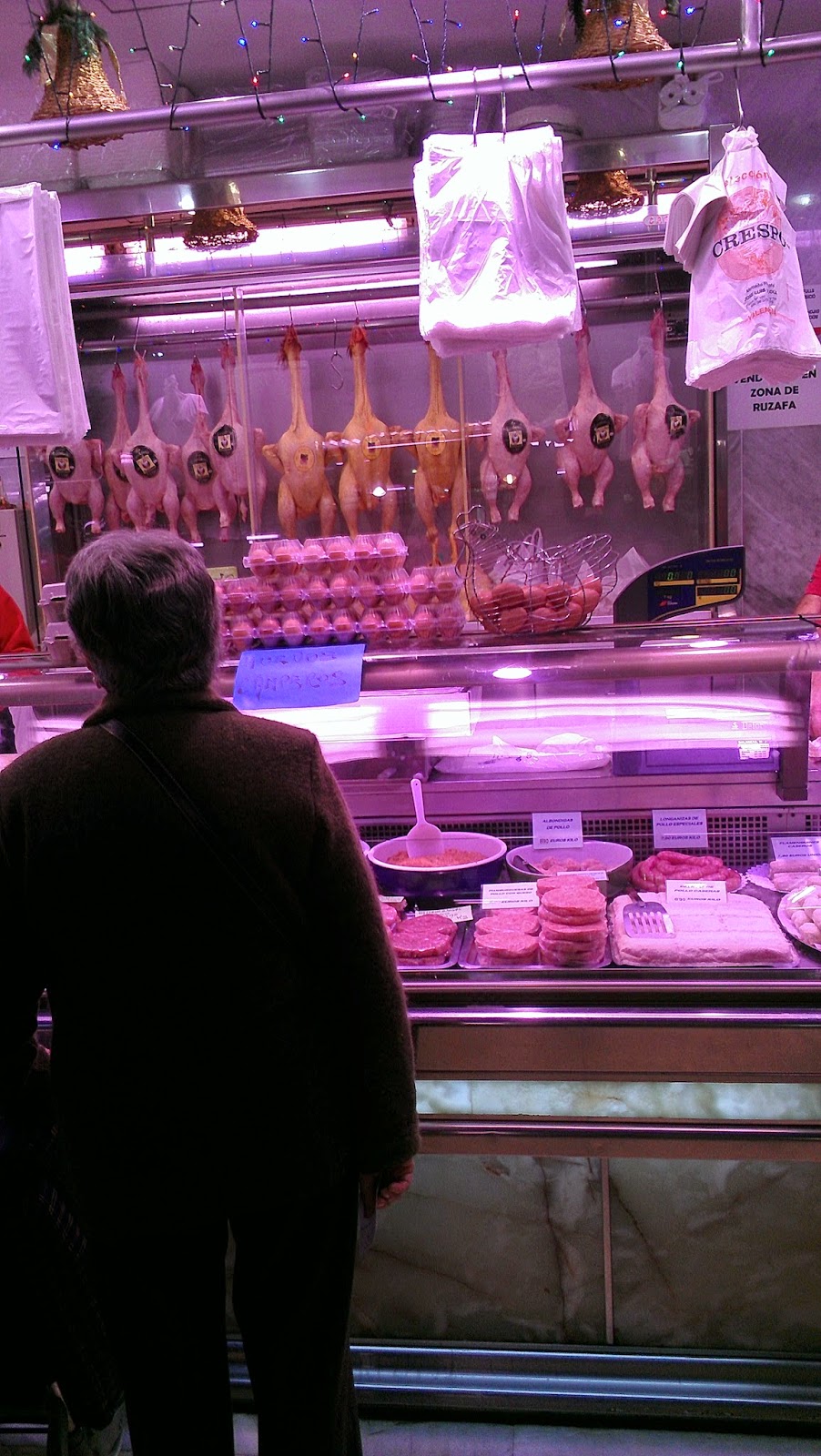

roasted pumpkins - you get to try before you buy

How to Do Valencia: Taste Authentic Argentinian Italian Pizza
I had no idea that there was a significant Italian community in Argentina, but I found out when I visited La Nonna - an Argentinian Italian restaurant in Valencia. The owners hail from Argentina, and the restaurant's menu boasts a mouth-watering selection of brick-oven Italian pizzas along with some Argentinian steak and meat dishes.
The pizzas are top notch - crispy but tender crust, fresh topping, and the gooiest of cheeses. La Nonna features a daily menu that allows you to select a salad or small plate as a first course, your choice of pizza, along with drink and a dessert for about 12euro.

Carpaccio de pulpo - La Nonna
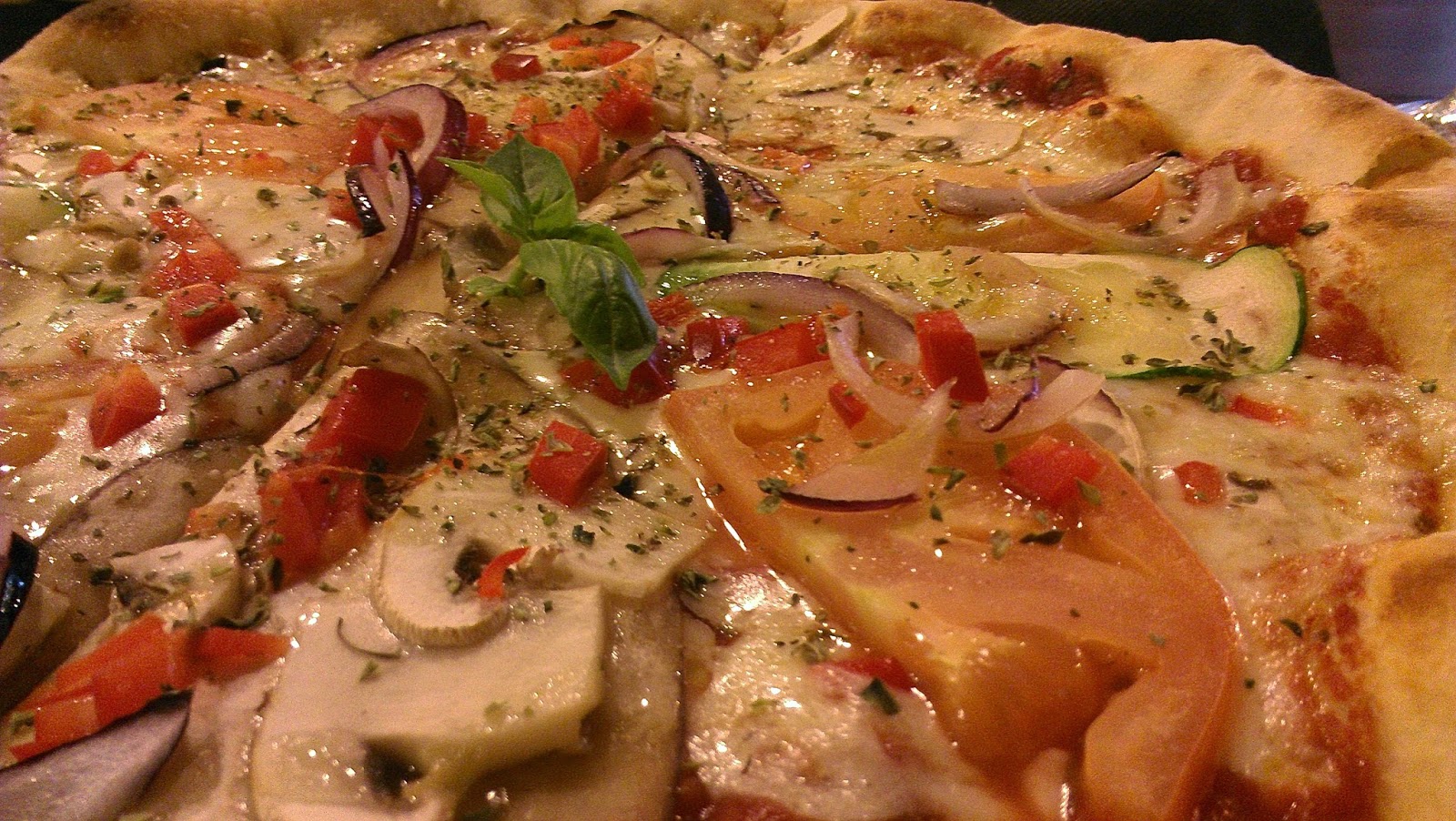
Veggie pizza at La Nonna
La Nonna Calle Puerto Rico, 16 Valencia, Spain
How to Do Valencia: Hang with the Hipster Set at Calypso
We enter the smallish bar and order a couple of beers. As my eyes adjust to the darkness, I wonder not only where I am, but
when
. The music is a non-stop selection of 60s surfer and ska tunes .The DJ, who for some unexplicable reason is wearing a Mexcan luchador mask, seems thrilled to be providing the ambience for the evening. He bobs his head and does a little funky two step to the music. I scan the rest of the room, taking in the scene. The decor is best described as retro tiki chic. Overhead, a tiny tv is showing original versions of the Super Friends cartoon. I am the only one paying it any attention, however. The rest of the steadily swelling crowd at Calypso presents varying shades of hipster as they chat and sip their drinks. Skinny jeans, wallet chains, lumberjack shirts, carefully ungroomed beards, blunt-cut bangs, cat eye glasses, red-as-red-can-be lipstick... all the expected accoutrements are there. Well, all except one. There's a total lack of irony among the patrons, instead there's an easy, genuine feeling of 'hey, we're just here to have a good time, not to pose and look cute.' As I approach the bar for my second round, the bartender holds up a vintage camera and captures me with a flash. The luchador-DJ points and nods his approval.



Calypso Russafa Carlos Cervera, 9 Valencia, Spain
How to Do Valencia: Have Sunday Paella with a Valencian Nationalist
Guillermo invites me out to have
beers with him and his friend, Vicént. “He’s very nationalist,” Guillermo warns. I’m not sure I like the sound of that. “What exactly,” I cautiously begin, “do you mean by ‘nationalist’?” “Well, he only speaks Valenciano. When a Spanish team is playing a football match, he roots for the other team. When he tells people where he’s from, he doesn’t say I’m Spanish, he says, I’m Valencian. If he could, he’d prefer that his passport said that, but since he can’t change it, he’s stuck with it saying he’s from Spain. But don’t worry, he likes to practice his English.” Well, I think. This should be… fun. As it turns out, Guillermo was exaggerating a bit. Or, maybe Vicént was on his best behavior. Throughout the night we shift as easily between English, Castellano, and Valenciano (them, not me) as we do from 1 bar to the next. At the second bar, after Vicént explains to me over the loud music that he lives in a neighborhood not far from the beach, I jokingly quip, “Oh, so you’re going to make a paella for us tomorrow?” As Guillermo had hipped me earlier, paella is typically eaten by Valencians for Sunday lunch, often just before or after a relaxing stroll along the Mediterranean. To my surprise, Vicént replies with barely a pause, “Yes! You should both come over around 3!” Wait. What? Guillermo had already offered to show me to a restaurant serving authentic paella that would be much better and cheaper than the touristy options along the beach. But, this? This was more than I could have expected. I turned to share the change in plans to Guillermo. His face instantly registered his shock. “Wow. That was fast!” he says

Vicent prepares what he says is not truly paella, but octopus rice. Guillermo supervises, beer at the ready.

Shared salad to accompany the main course

Vicent's 'octopus rice'

"This right here? Is how you do pumpkin," says Vicent.

All smiles! An after-lunch coffee at the cafe on the corner
How to Do Valencia: Take a Stroll Through El Cabanyal
After lunch, Vicént offers to show us around El Cabanyal – the neighborhood he grew up in and the same neighborhood his family lived in for several generations. “It used to feel like a little village,” he says. Originally a working class neighborhood of fisherman and port workers, it’s now plagued by urban blight. Kids play in the street right across from the older boys hanging out in front of the corner store. The older ones don’t go inside to buy anything. They stay outside all day to sell.


Vicént stops at regular intervals to point out one crumbling, dilapidated building after another. “My grandmother was born there. We used to go pick up huge chunks of ice over there. My uncle’s house was here. My first job was washing cars in that place over there.” I can feel the mix of wistfulness and pride in his voice.


Guillermo and Vicént share that the state of the neighborhood is an intentional move on the part of the local government. They want to expand a nearby avenue so that it connects with the beach further to the south – El Cabanyal is right in the path of this proposed throughway.
We leave El Cabanyal and stroll along the beach, catch a batucada group practicing their moves, watch the sun set over the waves. After our walk, Guillermo and I bid Vicént thanks and goodbye, and catch the metro back home.


How to Do Valencia: Have a Farewell Dinner for a New Friend
My first night in Valencia, while Guillermo and I were grabbing some eats in a nearby Cuban restaurant, I met Tanya. Tany
a was a native of Brooklyn, and was currently living and teaching English in Madrid. We all chatted cordially, and I invited Tanya to join Guillermo and I for bar-hopping after dinner. Tanya shared that she’d only just decided to come to Valencia for the holiday weekend last night. She was an experienced solo traveler, and could easily enjoy exploring a city on her own or with newly made friends wherever she happened to find them. Of course, we hit it off instantly. We exchanged contact info at the end of the night and hung out again for several hours the next day.
On Tanya’s last night in Valencia, we met up for a Moroccan dinner at Restaurant Zakaria. I'd read online about one of their more popular dishes, Cordero con ciruelas (Lamb with prunes), and decided to order it. Tanya ordered a couscous dish and we shared. While both dishes were delicious, the lamb dish was certainly more memorable. Sweet, smoky caramelized onions, well-spiced lamb, and tender prunes made for a warm, comforting blend of flavors - perfect for the slightly chilly evening weather. Portions and prices were quite good at Restaurant Zakaria. A must-visit if you like North African cuisine.


Cordero con ciruelas at Restaurant Zakaria

Chicken and vegetable couscous at Restaurant Zakaria
Our after-dinner plan to find a bar or club with some cool tunes was mostly a bust and ended up with Tanya and me going on a Google search-inspired wild goose chase around the city center that lasted ‘til the wee hours of the morning. But, in the end, it was all good. We had just as much fun getting lost, people watching, laughing like giddy teenagers, and even singing the hooks of old funk and soul tunes on the streets of Valencia. Sometimes it’s not so much about where you’re going, but who you’re travelling with.

Tanya and I outside of Havana, the Cuban restaurant where we met in Valencia
Carrer de Puerto Rico, 26, Valencia, Spain
How to Do Valencia: Head Down the River to the City of Arts & Sciences
On my last day in Valencia, I head out to explore the ‘river’, which is what the locals call the continuous band of recreational green space that snakes through most of the city. Many decades ago, it was an actual river, but after repeated floods, it was drained and turned into a park. The weather is as perfect as it can be, and there are tons of people enjoying the day – running, strolling, biking, or just soaking up the sun.



At the south end of the river, I encounter the City of Arts and Sciences, a complex of museum buildings, each one dedicated to a specific area of scientific discovery and exploration. For the sake of time, I opt not to go inside of the museums. The buildings themselves are breathtaking works of art. The combination of futuristic architecture, glittering water features, and the shifting light of the sun makes for a unique visual feast. I take far too many pictures as I walk.







How to Do Valencia: Watch a Revolutionary Screening at Recordshop
When I return to Guillermo's, he asks if I’d be up for seeing a free documentary screening at a nearby bar this evening. “Sure. Which documentary?” I query. He shows me the flyer on his computer. I nearly squeal with excitement. Turns out it’s Wattstax. I’ve been wanting to see it for years, but have never gotten around to it. I’m thrilled to have the opportunity now. We head out a little while later to Recordshop, which is part bar, part ‘cultural association’ with lots of vinyl on display. The owner regularly screens films in the space that is about as big as a large living room. Before the movie, the owner plays Jimi Hendrix’s ‘Axis: Bold as Love’ album (on an actual record player), while Guillermo and I sip beers. Soon, the movie begins. I settle into a worn couch and immerse myself in the sounds of a soulful revolution.


Recordshop Cultural Association Calle Sevilla, 31 Valencia, Spain
How to Do Valencia: Savor Handcrafted Burgers at Slaughterhouse
For my last meal in Valencia, Guillermo and I head to Slaughterhouse, a popular burger restaurant that actually was a slaughterhouse in a previous incarnation. We’d walked past the place on my first night in town, and the smell wafting out onto the street had instantly grabbed my stomach by the nose. Online reviews and Guillermo's own personal recommendation confirmed that this place made some really tasty burgers, so I was glad to have a chance to sample one before heading home. Each of the burgers on the menu at Slaughterhouse gets its name from a fillm or book that is also listed as a recommendation on the menu. All the ingredients on the burgers are fresh and/or homemade, all the way down to the ketchup.I don't always eat burgers back in the States, but when I do, I want it to be a damned good burger. Here in Spain, I've tried burgers a few times, but they've always been 'off' somehow, falling short of my expectations for a well-prepared, proper tasting burger. Thankfully, I found redemption at Slaughterhouse. The Movska burger that I ordered was everything I'd been missing from home. By this time, I wasn't even surprised. After all, in just a few days in Valencia, I had already found so much that made feel right at home.

Slaughterhouse menu

The Movska burger at Slaughterhouse

A disco ball and a meathook - part of the eclectic decor at Slaughterhouse
SlaughterhouseCarrer de Dénia, 22Valencia, Spain
How I Got There: AVE High Speed Train (Spain Pass)
I'm a heavy user of Spain's discount railway pass for non-Spanish travelers. It's called Spain Pass, and I've used it several times to visit cities that are far enough away for me to want to avoid a bus ride (my bus limit is about 3 hours). The trip to Valencia from Ciudad Real took a little over 2 hours on the high-speed train. The same trip would by bus would take about 6 hours, and cost about the same.

Have you had a chance to visit Valencia yet? Share your favorite finds in the comments!
how do you say 'mercury retrograde' in spanish?
My First Big Mistake
My Second Big Mistake
7 things you must see in every spanish city
1. Its cathedral
 |
| The Cathedral in Toledo |
 |
| Christopher Columbus' remains - inside Sevilla Cathedral |
| In Cordoba - the Cathedral is located inside of a mosque |
2. If it’s on a coast, its beach. If not, its Plaza Mayor
 |
| Waiting on fresh catch at a chiringuito at Malagueta beach |
 |
| Plaza Mayor in Ciudad Real at Christmas |
 |
| Picture-perfect view of Marbella's beach and Paseo Maritimo in winter |
3. Its most popular tapas bar or cervecería
 |
| Complimentary chupitos in Granada |
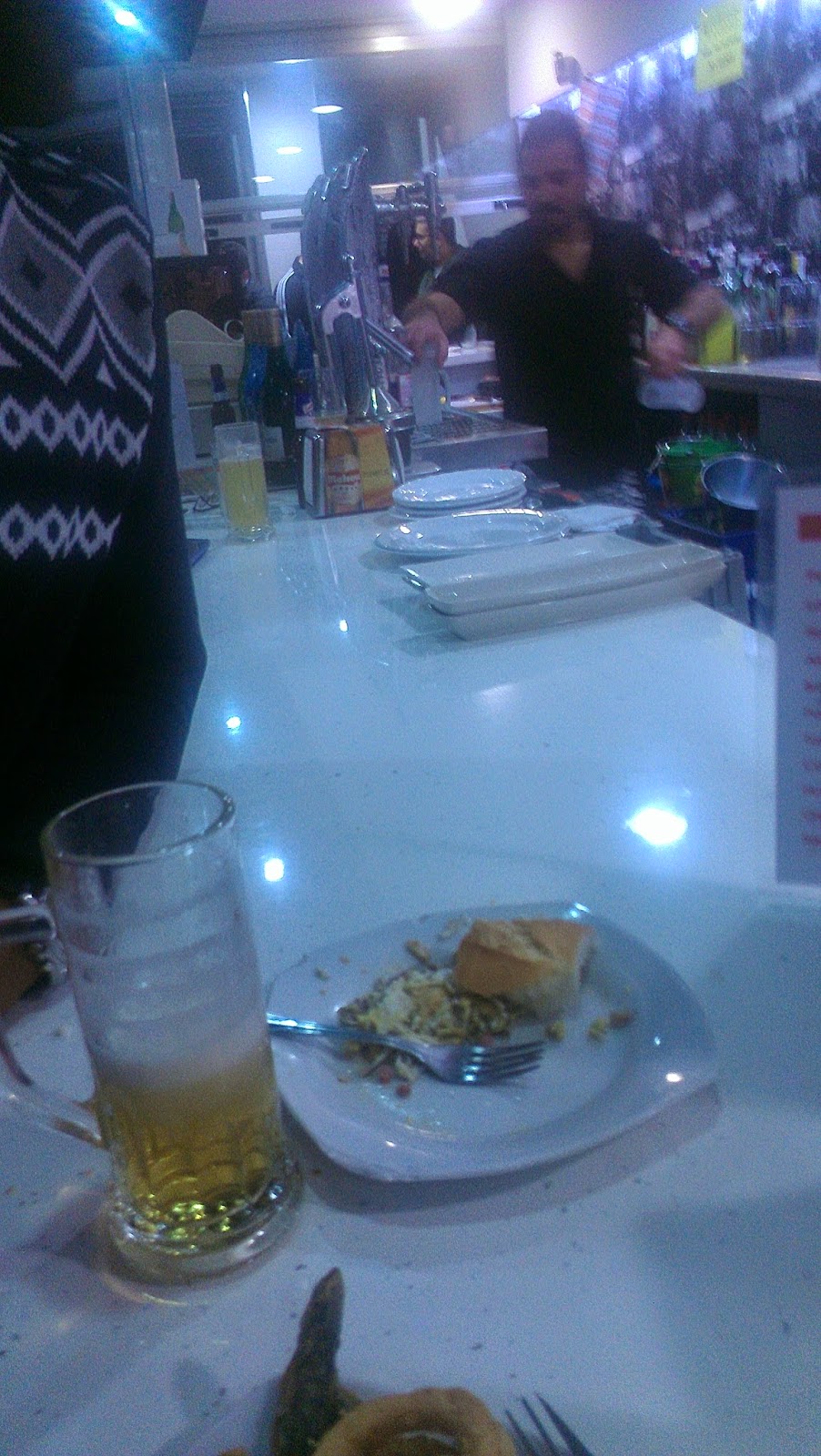 |
| Ciudad Real's El Alcazar - always crowded, always good. |
 |
| At Malaga's Antigua Casa de Guardia, the waiters chalk up your tab on the bar. |
4. Its ethnic neighborhood
 |
| At Baobab, a Senegalese restaurant in the Lavapies neighborhood of Madrid |
 |
| In Valencia's vibrant Ruzafa 'hood, new restaurants seem to pop up every day. |
 |
| At A Tu Bola, in Barcelona's Raval district, fusion albondigas are on the menu. |
5. Its municipal market
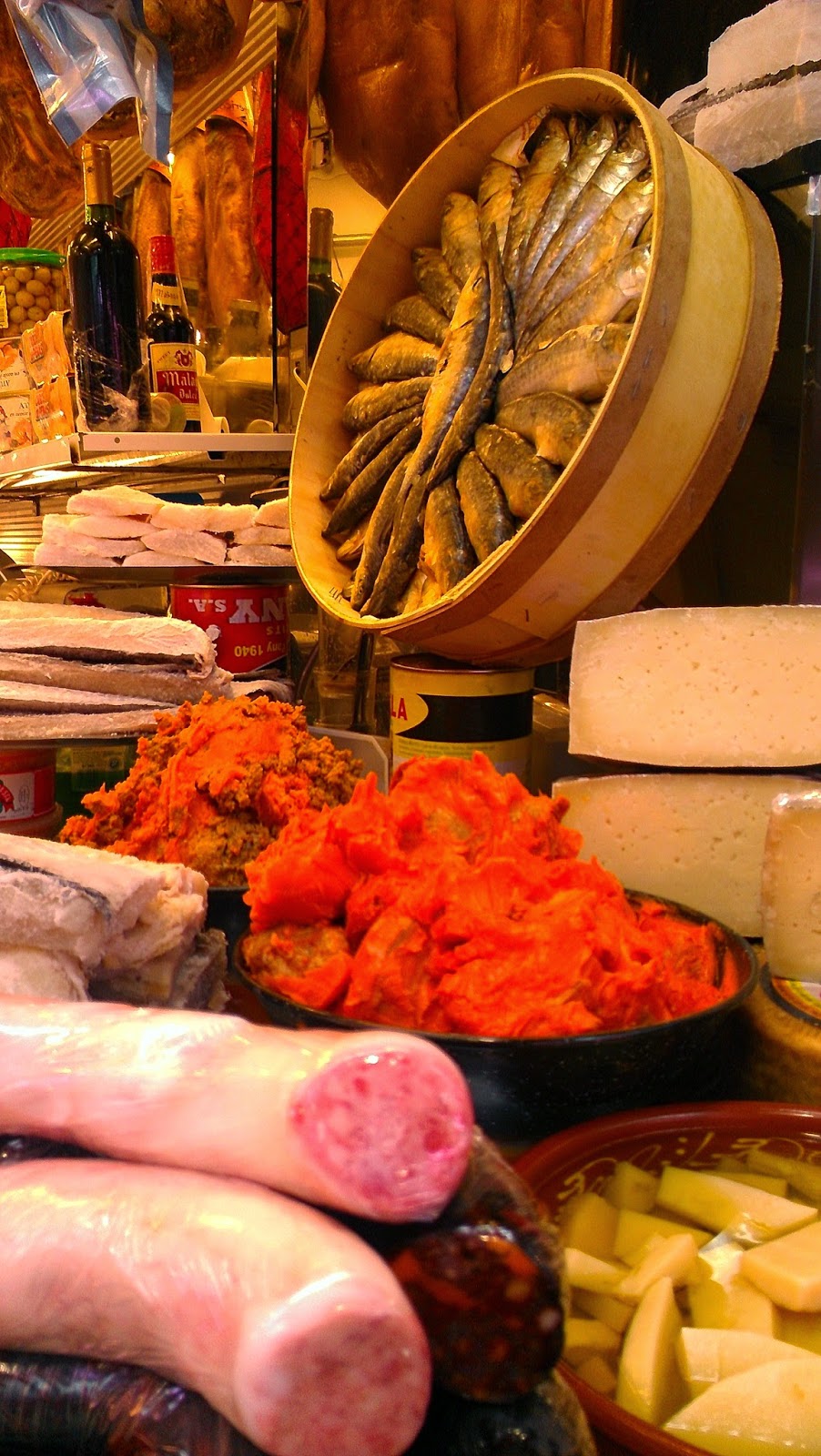 |
| Atarazanas Market, Malaga |
 |
| The central market in Cadiz is a bustling bar scene at night. |
6. Its Casco Antiguo
 |
| The most breathtaking views in Ronda are found in its old town |
 |
| Even in modern Marbella, there's a charming casco antiguo to get lost in. |
7. Its lesser known park
 |
| Ciudad Real's Parque del Pilar |
 |
| Jardin el Capricho - Madrid's other park |
espere tu turno, gracias.
 |
| Emilio. Waits for no one. |
toto, we’re not in marbella anymore
Adjusting to a new place can be hard. And, though the process has only just begun for me, I think that adjusting to Ciudad Real will definitely present some challenges, mainly because I can’t help but compare it to my stint in Marbella. So far, there have been a few things that have stood out as being distinctly different than my previous experience living in Spain. Not all of them are bad differences, but they’re certainly noticeable. Here are a few:
- They don’t speak Spanish here. I found out this little fact when one of the teachers at my school complimented me on my speaking. To my surprise, she didn’t say, “Hablas español muy bien,” instead I got, “Hablas castellano muy bien.” In my head, I gave her the ‘whatchoo talkin’ ‘bout Willis?’ face, but on the outside, I kindly thanked her and went on with our conversation. Of course, castellano and español are exactly the same thing, but since we’re in Castilla La-Mancha, I guess that’s what they prefer to call it here. Also there are some words they use here that I never heard in Andalucía. For instance, instead of saying ‘mira’or ‘mira eso’ (look at this / check this out), they say ‘fijate’. The first time I had someone say it to me, I thought I was being asked to fix something. They also use ‘metalico’ instead of (or, in addition to) ‘efectivo’ to mean cash. I’m not sure if that one is specific to this region, but I’m pretty sure I’ve only heard it Ciudad Real.
- It’s flat – One of the first things I noticed when I was doing my initial explorations around Ciudad Real was how flat the landscape was. In Marbella / Málaga, I was situated between the sea and the mountains, so there were lots of hills and steep inclines. The good thing about this is that the flatness makes getting around on foot a lot easier and less tiring. However, it might not be best for keeping my buns and thighs tight – a nice side effect of my daily walking commute in Marbella.
- It’s super dry – Technically, Ciudad Real is in the middle of the desert. Unlike Eliza Doolittle’s song would suggest, there is very little rain in the plain in Spain. The reverse was true in Marbella. Proximity to the sea meant high humidity, and also a short lifetime for clothes to dry. But being a long-time resident of Atlanta, humidity is something I’m very accustomed to. Here, I’ve already seen the effect the dry climate can have on my hair, skin, and mucous membranes. That family-sized jar of shea butter I brought along probably won’t last me ‘til spring. And I frequently tote a little bottle of saline spray to keep my nasal passages from drying out and leaving me with achy sinuses.
 |
| You got it wrong, boo. |
Update: Though the atmosphere is generally dry, since I originally penned this post, I've seen lots more rain. In fact, it's probably rained as many times here in the last month and a half, than it did my entire 6 months in Marbella. Sorry, 'Liza. I take it all back.
- The local vegetable is pork – Seriously, these people luuuuuv some pig meat! I’ve already had a few restaurant meals where pork was served for each course. In fact, on a recent tapas excursion with Pablo (Juana’s husband) and some of his friends, a plate of pig ears showed up on the table. I shared with the group that people in the South have an expression that we eat everything on the pig from ‘the rooter to the tooter’. It seems Pablo was already familiar with the concept, as the manchegos have a similar expression. I can say, however, that the quality of the pork here is amazing – I’ve had some cuts (particularly presa iberica) that were extremely tender, juicy, and flavorful without being overly porky (that’s a scientific term, ya know).
- Nobody takes the bus. Well, not nobody. But when I think back to Marbella, I recall how the bus was almost full every day with locals, seasonal residents, and tourists of all ages. I’ve only taken the bus twice in Ciudad Real, and the only other people on there were either very elderly or riding along with a small child. Plus, the buses seem to take these long, circuitous routes that makes them the least efficient mode of transportation for getting around town.
- It’s small. Like, really small – If I have my ‘marching on Selma’ strut on, I can pretty much get from one side of town to the other on foot in about 30-35 minutes. This would explain why hardly anyone takes the bus.
- It’s cold. Like, really cold – My first couple of weeks here were actually unseasonably warm. In late October, temperatures reached highs of around 70 degrees Fahrenheit during the day, with lows in the 60s. However, since Halloween, all that has changed. Unlike Marbella where winter spelled more rain than true cold and lasted for all of about 45 days, I can already tell that, here, there will be winter. Cold as a witch’s tit winter. It’s already been down in the upper 30s a couple of nights. And I’ve already realized that my assortment of blazers which served me well in the south, won’t stand much of a chance against these temps.
- There is a famine of beauty. Remember when I shared that the abundance of natural beauty was one of the most amazing things about Spain during my previous stint? Umm… yeah. Not quite the case here in Ciudad Real. Strangely enough, this is one of the few Spanish towns that I’ve been to that doesn’t have a casco antiguo – or historic quarter – with beautiful old buildings and charming cobblestone streets. Nope, Ciudad Real is surprisingly regular. Architecturally speaking, there isn’t much to look at. And since, as I mentioned, it’s in the middle of the desert, the surrounding landscape doesn’t immediately grab the eye. I don’t doubt that are some breathtaking views and scenes to see here, but for now, it looks like I’m gonna have to work a bit harder to find them.
From Wikipedia entry on Don Quixote, “La Mancha is a region of Spain, but mancha (Spanish word) means spot, mark, stain. Translators such as John Ormsby have declared La Mancha to be one of the most desertlike, unremarkable regions of Spain, the least romantic and fanciful place that one would imagine as the home of a courageous knight.”
- The stares. Dear god, the stares! Now, I’m used to being one of a relative few brown faces in a Spanish town. As such, I’m also used to getting the occasional stare from passersby on the street – it happened on several occasions in both Marbella and Málaga. Spanish people from other parts of the country are also known for openly staring at almost anyone – I’ve just chalked it up as a cultural difference. However, while staring was noticeable in Marbella and Málaga, I never felt it was excessive. It’s a totally different story here in Ciudad Real. During the roughly 20-minute walk from my flat to my school, I’m sure to receive no less than 10 blatant (like, stop in your tracks, squinch up your face, forget to chew your gum) stares from people I pass on the street, or even people passing by in cars. At first, I took it with the same bemused attitude that I did when I lived in Andalucía. But as the days have passed, the stares have kept coming. It’s a bit unnerving at times. Nothing makes you feel more like a stranger – or even like an unwelcome guest – than people looking at you strangely all day long. And I know it’s not just my own self-consciousness, as I’ve had some of my new friends comment on – and even apologize for – the excessive staring that they notice when they’re walking along with me. While I think it’s noble and sweet of my new friends to take some responsibility for what I perceive as the rudeness of their fellow countrymen, I know it’s not something that’s going to change anytime soon. Because Ciudad Real is such a small, largely homogenous town, I’m probably going to keep getting stared at, and I’m going to have to keep not taking it personally. I’ve taken to walking around with my headphones on to help insulate myself from that feeling of ‘otherness'. I realize that some of the stares are simply curiosity, some are even complimentary, but most are because many of the people here have never ever left their home town or region, so they’re not used to seeing different people, and some of those may not even like seeing different people. I was talking to a friend of Pablo’s recently – an over 30-year-old woman who is una manchega, born and raised in the area. We were talking about how much we both loved Barcelona. She ultimately revealed that her first time visiting the city (which is only about 3 or so hours away by train) was this past summer. I was completely shocked! How do you live in a country this small for all your life and never visit what is arguably its most popular city? Of course, I know similar people in my hometown of Macon and even people from Atlanta who’ve never travelled further than a neighboring state. But I think it surprises me even more here in Spain, given how easy and relatively affordable it is to travel from one region to another. Still, I knew well enough not to stare at her for it.
highlights (and lowlights) of granada
For my first weekend excursion from Marbella, I chose to head to Granada. It's less than 3 hours away by bus, and there were a couple of other girls from my CIEE orientation heading there for the weekend as well, so I figured it was a good time to check out what the city had to offer.
When I arrived, I had the good fortune of bumping into my friends as soon as I got on the bus to head to my room for the weekend. We made plans to meet up for tapas and drinks later that night, and they headed off to their hostel nearby, while I went to go check in with my AirBnB host.
Lodging / Accomodations
Highlights: My room was right in the center of Granada, located almost directly behind the Cathedral, and with easy access to all the city buses. Lots of shops, restaurants, and bars were right out the front door, and since it was in the historic area, the architecture of both the room and the surrounding buildings was a beautiful sight to see while moving about. My host also had maps, and information on popular sights and attractions in Granada already in my room. And the nicest touch of all? She had a hot water bottle available for my use - a lucky stroke since I'd decided to leave mine at home. Did I mention how cold most Spanish homes are in the winter months?
Lowlights: All that historic architectural charm - close-together buildings, narrow cobblestone streets, high ceilings - also meant that noise from the street below could be heard as clear as a bell in my room. There was more than 1 time that I thought someone was in the apartment with me, but it was actually sound coming from the street below.
Sights, Tastes, and Sounds
After checking in to my room, I met up with my two colleagues I'd seen on the bus - Allison and Nicole. We headed straight for nearby Calle Elvira, a main artery running through a network of alley-like streets filled with tapas bars, teterias, kebab shops and vendor stalls tightly packed together, giving the whole area the look of an old Moorish marketplace in the middle of modern-day Spain.
We made our first stop at La Antigualla for our inauguration into the free tapas phenomenon we had all heard about but had yet to experience. Another auxiliar, Laura, who lives/teaches in Granada met up with us later. The four of us spent the rest of the evening bar-hopping and getting our fill of copas and tapas while catching up on our experiences-to-date as new auxiliars.
The Alhambra
The next morning I was up early (well early-ish) to head to the Alhambra. After a quick walk to catch the bus, I arrived at the Alhambra gates, purchased my 15€ ticket, grabbed a quick croissant and coffee in the snack bar, and headed in to get started on my self-guided tour.
The Alhambra is an ancient palace and fort built for Moorish royalty in the 9th century and subsequently added on to by different Muslim and Spanish rulers up to the 14th century. There are four major structures to see within the Alhambra:
- The Palace of Charles V,
- The Alcazaba,
- The Palacios Nazaries,
- and the Generalife.
Over the next 4+ hours, I strolled throughout the massive complex, taking in the ancient beauty of the place. The original theme for the Alhambra was 'paradise on Earth', and it certainly feels like that when you're there.
Unfortunately my phone (and hence, my camera) died just as I reached the Generalife, so I have no pictures of it to share.
After leaving the Alhambra, I caught the bus back to my room for a quick rest and a phone charge, then headed out to meet Allison and Nicole, and a different CIEE auxiliar also living and teaching in Granada, Brit.
I linked up with the 3 ladies in Plaza Nueva, and over a quick bite to eat, we decided to head to the Albayzín. Since Brit had been before, she would serve as our unofficial tour guide.
The Albayzín (Albaicín)
The Albayzín is a maze-like neighborhood in Granada. It's yet another slice of Spain's ancient Moorish past that still exists today. The neighborhood is built in the style of a North African medina, with winding streets so narrow that, in certain places, cars can't even pass through. The neighborhood extends up into the hills overlooking the city of Granada. My AirBnB host had told me that gypsies lived up in the hills in a sort of shantytown, and that on some evenings, if you went walking through at the right time, you could see them performing flamenco in the caves up there. I wasn't all that sure about how I felt being caught with some dancing gypsies in a cave after dark, but I was game for a pre-sunset excursion.
After we'd walked for a while, I noticed the sun was getting lower and lower, and we weren't showing any signs of turning back. The cobblestone streets had ended, as had any signs of a real neighborhood. We were entering shantytown territory and Brit was steadily leading the charge. I put up a futile protest as we started a short, but steep climb up a gravelly path that would take us deeper into shantytown. Not only was I already pretty tired from my all-morning tour of the Alhambra, but I also kept thinking to myself, "It's getting dark. And there are gypsies." Yet, we pushed on.
In the end, I was glad I didn't let my tiredness or wariness get the best of me. The views from the top were amazing. We arrived just as the sun was beginning to set. With the snow-capped mountains in the distance, the impressive Alhambra in the foreground, and the beautiful city of Granada below, it was a view so stunning that my poor little camera could never do it justice.
After lingering about for tons of pictures and a quick rest to watch the sun go down, we started our descent back through the Albayzín to the center of Granada. On the way, I saw some nice works of graffiti.
Botellón and Bars
I returned to my room for a disco nap, then met up with 3 of the ladies for a quick taps before heading over to Laura's apartment where we would join her and her roommates for a night out. It all unfolded something like this:
.jpg) |
| Before: Gracias por tu visita. After: Gracias, puta! |
 |
| A quick copa before heading to Laura's. A free tapa too, cuz... why not? |
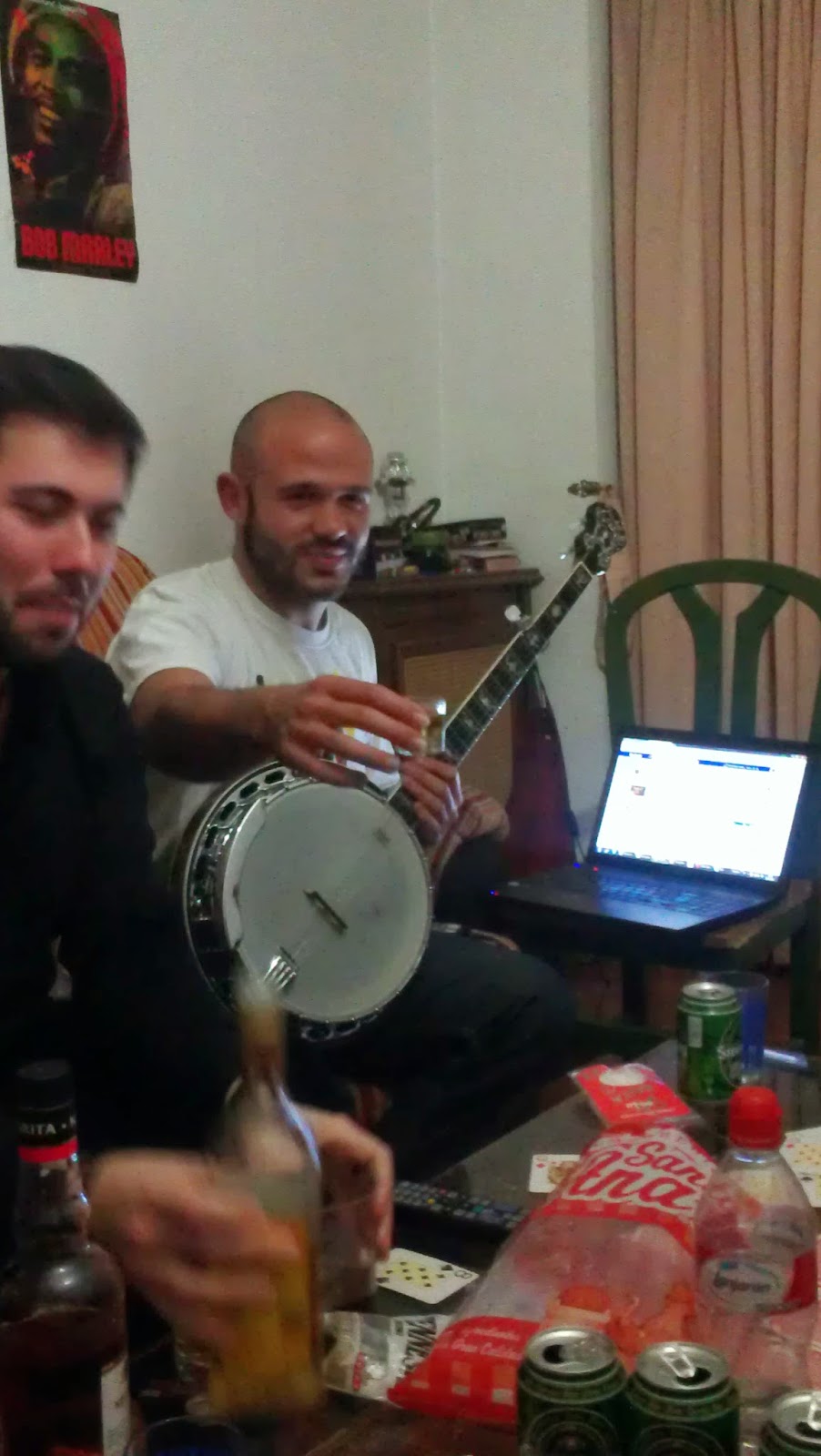.jpg) |
| Pre-gaming, botellon style. Try it at home! Banjo optional. |
My loose interpretation for botellon, is 'bring a bottle and some of those cups...'. Though they usually occur outside of the house in a plaza or park, I think it's far to call anything a botellon that involves more than 1 person bringing more than 1 bottle to share with the intent of drinking as much as possible before the night is over.
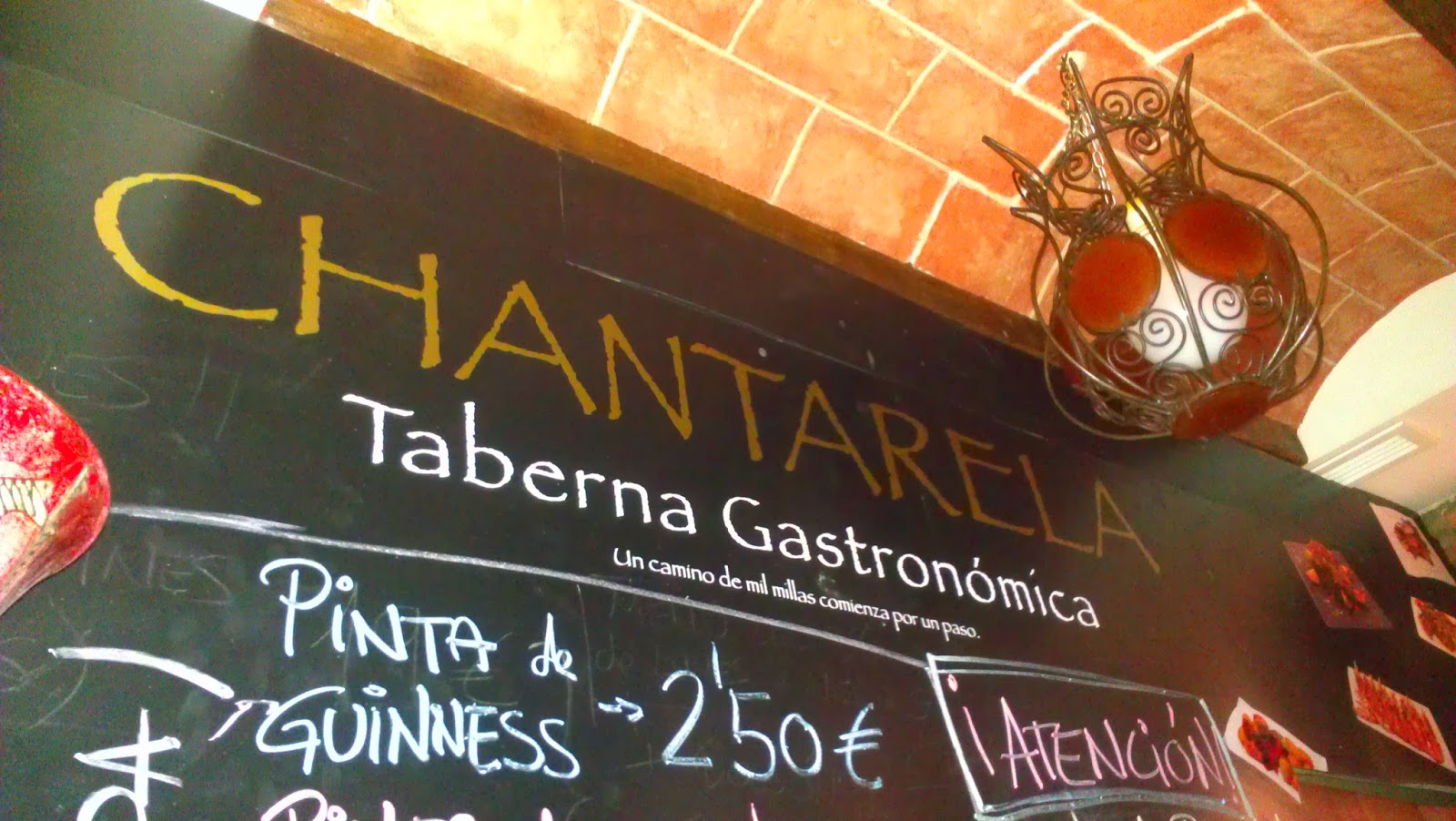.jpg) |
| First, to Chantarela for a few rounds of tapas and copas... what else? |
.jpg) |
| Our next stop was a crowded, energetic bar where this guy ogled me in the bathroom. I didn't mind. |
After a several hours of making the rounds, we night creatures all headed back to our coffins. By the time I made it back to my room and collapsed, it was a little after 4am.
La Morena Comes to Visit
"Oh crap, what time is it?" was my first thought upon waking the next morning. I was supposed to be meeting up with Dominique (aka, La Morena de Andalucia), who I had pestered until she agreed to come into Granada so we could hang out for the day. We strolled around Granada catching up on everything until it was time for me to head off to my appointment at the nearby hammam.
 |
|
|
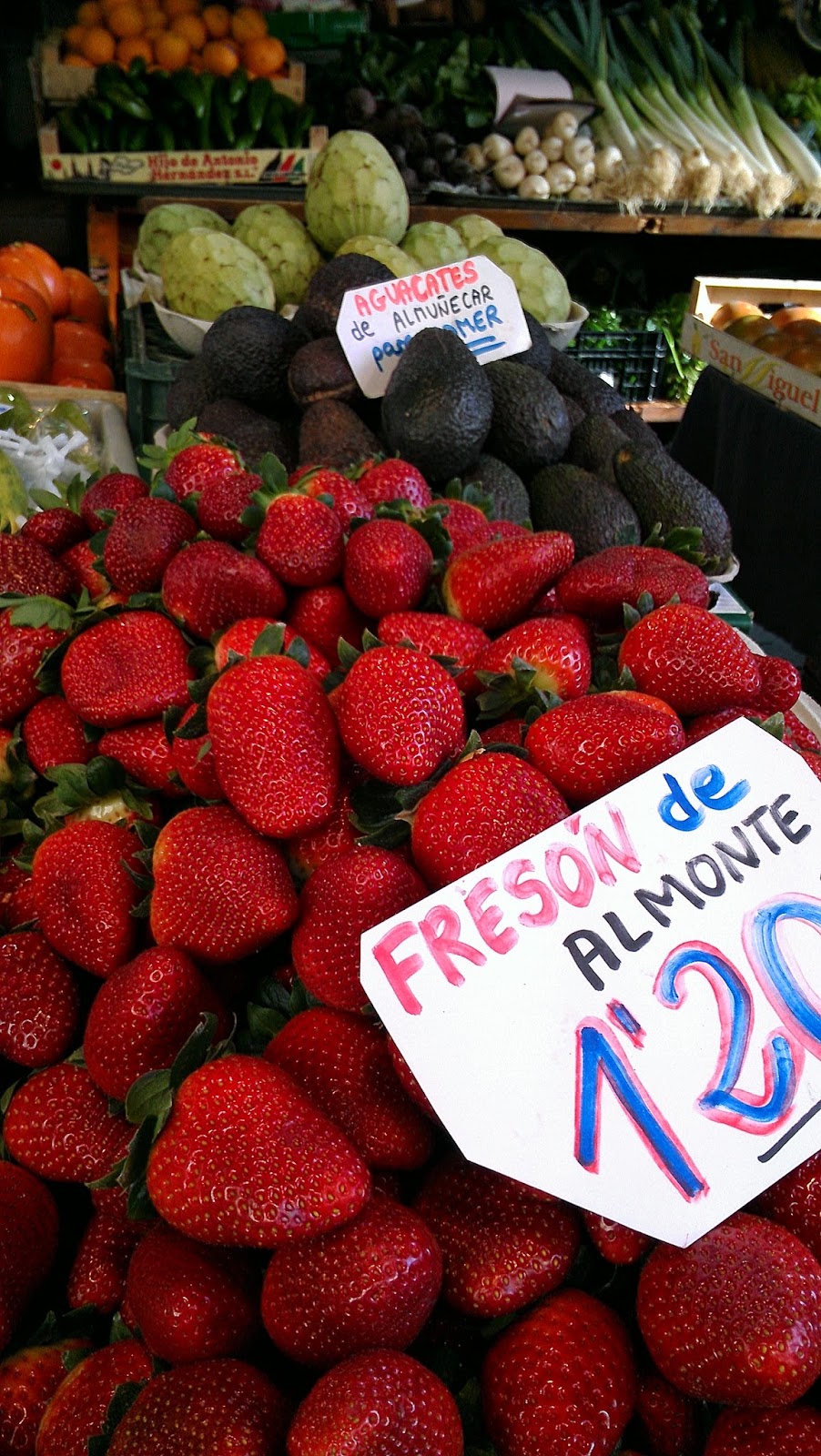.jpg) |
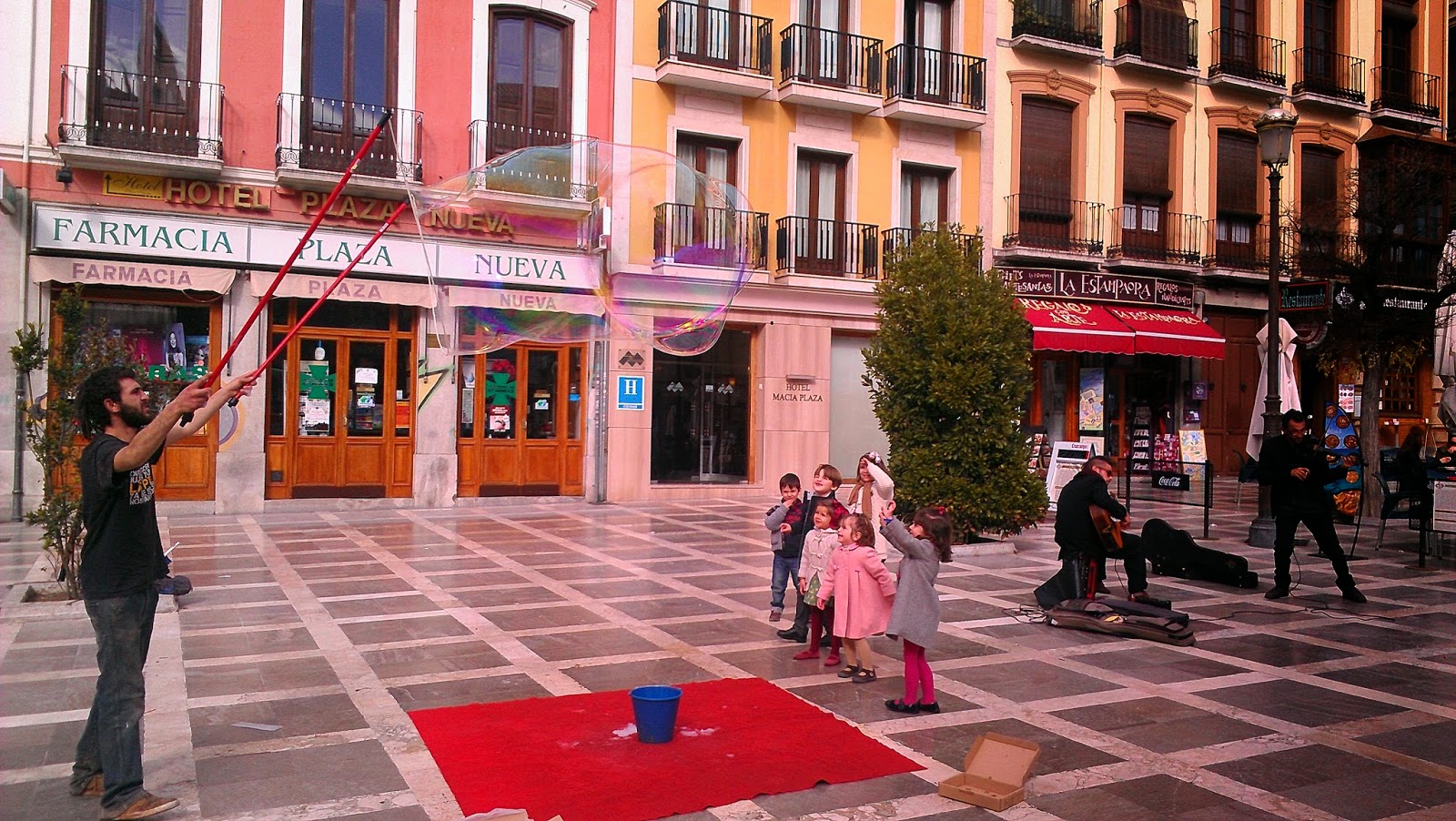.jpg) |
| kids playing at plaza nueva |
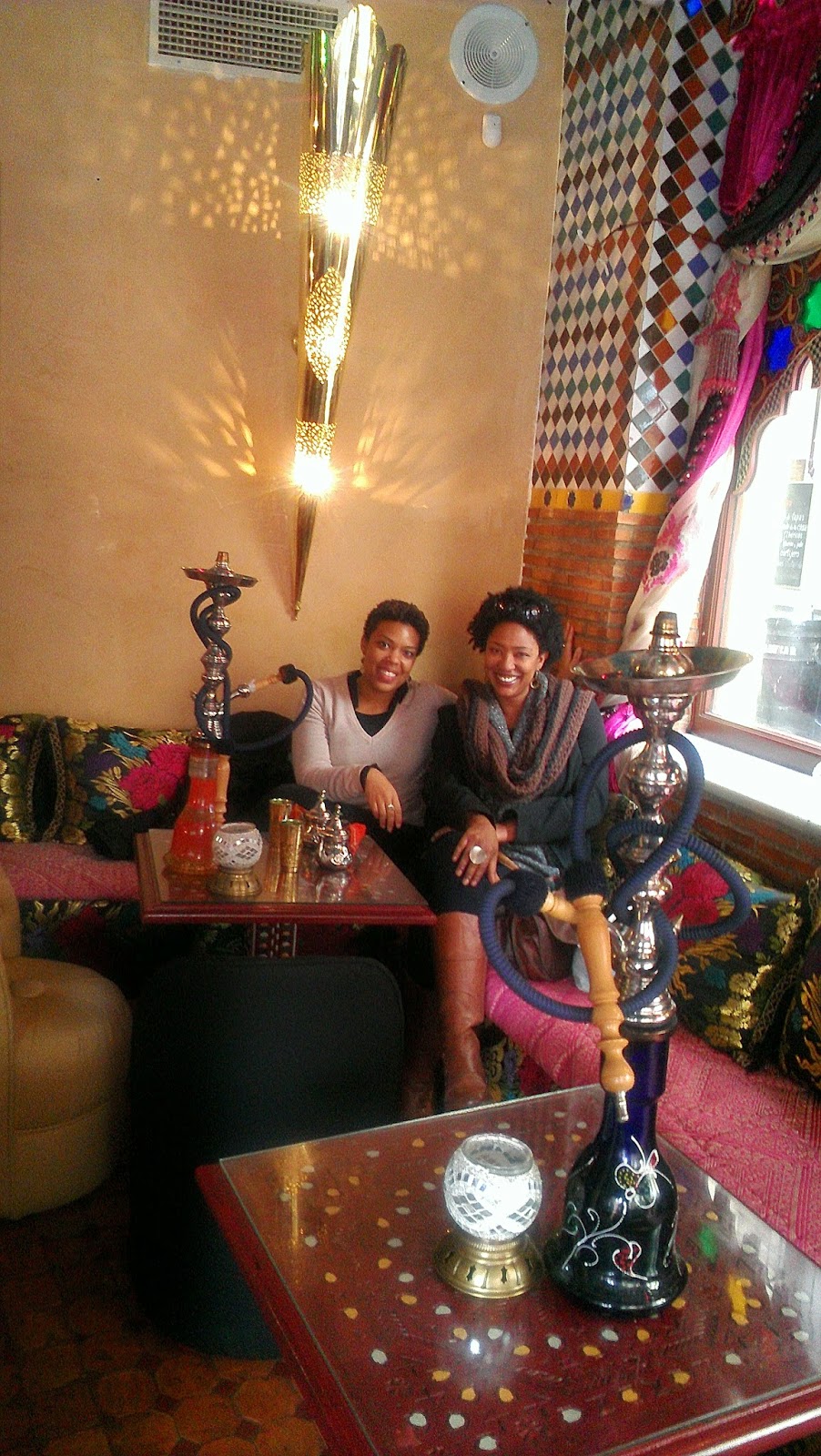.jpg) |
| 2 for tea - Dominque and me at a teteria on Elvira |
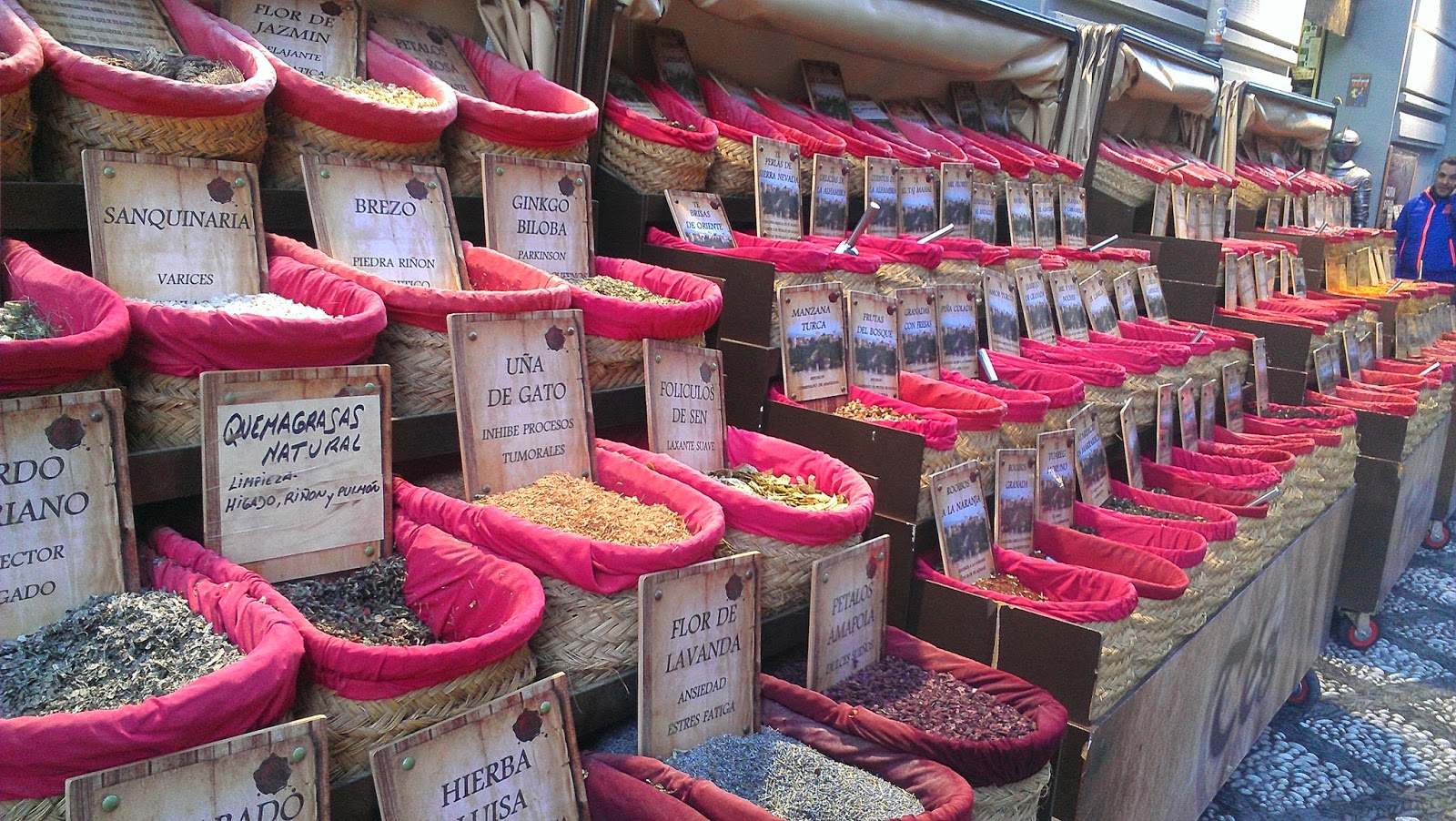.jpg) |
| spice vendor near granada cathedral |
Hammam Al Andalus
After all the walking at the Alhambra and the Albayzin the previous day, followed by a long night of 'botellon and bars', my poor body needed some rejuvenation. The Hamma al Andalus was right on time.
.jpg) |
| No pictures allowed inside. But I managed to sneak this one of me with my shoe shower caps. |
Inside the hammam are 3-4 'baths' or large soaking pools - each has a different temperature (from ice cold to warm-but-not-hot). There's also a steam room and a massage area. My entry fee of 25€ included admission to the baths for 2 hours and a 15-minute massage. The massage was pretty good, and I felt the price was fair, especially because I needed it so badly.
After the hammam, I met up with Dominique, Nicole, and Allison (aka, the out-of-towners) for tapas at Bella y la Bestia.
.jpg) |
| I'm giddy from an excess of carbs and a lack of sleep. |
Soon, it was time for Dominque to head back to Huelma. We hung out a bit more around Elvira, and then I saw her off to the bus station.
Shisha and Bars
Saturday night. Last night in Granada. So I start it off by meeting up with Brit for shisha and a nice cup of tea. We're both a little hungover from the night before, and before we leave the teteria, Brit throws in the towel and heads home for the night. Fare thee well o Hiawatha. Fare thee well, O mighty warrior.
I went on to meet up with the rest of the girls for a couple of bar stops:
First, at Chantarela (Yes, again. Cuz it was that good.)...
Then, at Poe, where Allison had her first taste of absinthe...
And finally, at one of these interesting Spanish drinking establishments I call 'shot houses' - a bar that's really popular because they serve a dizzying array of shots for about 1euro each.
All in all, it was a nice way to wrap up the weekend.
And it was a good thing I booked my return bus for the afternoon. I definitely needed to sleep in.
my culinary adventures in spain - eating out
As I mentioned in an earlier post, I've been surprisingly underwhelmed by the food here in Spain. Before coming here, I imagined that I'd be in absolute gastronmic glee over all of the delicious food available. Not exactly the case. But still, I've had some delicious and some very inspiring experiences with food that are definitely worth sharing.
EATING OUT
Tapas
The Spanish are best known for tapas. They invented the whole concept of small plates eaten / shared with friends over rounds of drinks. They've even made a verb to express the act of having tapas - tapear. Almost every Spanish restaurant offers a selection of tapas along with larger portions called raciones. However, there are two things that have left me feeling lackluster about the whole tapas experience: 1) every restaurant generally has the exact same selection of tapas (oh, look, they have croquetas!), and 2) none of them are prepared exceptionally well. They're not bad, mind you, but compared to my hyped-up expectations, they're not that great. Yet, thankfully, there have been exceptions:
In Sevilla, La Morena de Andalucia (aka, Dominique) showed me her favorite tapas restaurant, Duo. Located on the Alameda de Hercules, this little bar serves up some more creative twists on traditional Spanish tapas. The higher quality of the ingredients is noticeable as well. So far, this ranks as my #1 restaurant meal in Spain.
 |
| @ Duo Tapas in Sevilla. foreground: pulpo a la gallega; background: carillada |
In Cádiz, the tapas were tastier than the usual, and seemed even better because they were cheap and plentiful.
 |
| @ La Isleta Bar in Cádiz. left: carillada; right: pescado en salsa roma |
In Granada, the tradition of buy a drink, get a free tapa is alive and well. Unfortunately, the free tapas are mostly carb-heavy, not-that-great snacks. But Chantarela is a tapas bar that does justice to free tapas.
 |
| Standard free tapas in Granada. Carb-tastic! |
 |
| Free tapas at Chantarela in Granada. |
Beer
One of the very first things I learned when I arrived in Sevilla was how to order a caña. A caña is basically a half-pint of beer, and usually costs about 1€. It's common to have a caña before/with/after lunch, after work, or basically any time you need to take a quick break with a refreshing beverage. I've even started to use the caña as a standard for pricing other things. For example, "Wow. That bus ticket costs 2 cañas!" Spain has several local / regional beers that are only slightly better than Budweiser, Coors, or PBR. When you order a caña, you'll usually be served either Cruzcampo, Mahou, Alhambra, or San Miguel depending on what city you're in. All of them are your standard lager - refreshing, effervescent, uncomplicated and, honestly, quite perfect after a long day of walking around in the heat. But not too exciting in the way of flavor or body.
More recently, I've lucked up and found a few craft beer dispensaries. The phenomenon of craft and artisan beers is still fairly new here, so you often have to look a little harder to find a place with craft beers. Also, many of the shops or bars only have bottles, not taps. Still, there are some really good brews to be had, and the prices are on par with if not a little better than what you might find in the States. Right now, my favorite Spanish craft brewery is Naparbier - I've tried 2 of their Saisons and 2 IPAs, and loved them all. Plus, they have some really cool bottle art. One thing I've noticed in my tastings is that Spanish IPAs are not as over-the-top hoppy as others I've tried. They still have the prominent grassy or floral notes of an IPA but not the huge, hoppy 'bite' that I dislike about American IPAs.
 |
| Gulden Draak at La Tienda de Cervezas (The Beer Store) in Madrid. |
 |
| Just a sliver of the bottled selection at La Tienda de Cervezas, Madrid |
Freidurías
Ok. So there are these places here, right? They serve nothing but various fried things. It's like a Southerner's dream come true. Well, at least this Southerner's. You can find freidurias anywhere - in municipal markets, as standalone restaurants, or takeout-style counters. The menu selection in a freiduria consists of a variety of frituras, which I lovingly call, 'frieds'. You can choose from a selection of fish and seafood (anchovies, calamari, squid, etc.) or vegetables (eggplant, mushrooms, peppers, etc.). The best freidurias use a very light and crisp coating or batter for the fish, and I think most all of them use olive oil for frying. The result is a crispy, light-tasting exterior that doesn't mask the flavor or freshness of the fish. With a wedge of lemon to squeeze all over crispy, bite-sized pieces of fish hot out of the fryer, I am in heaven.
 |
| 'Frieds' at a stall in the municipal market in Algeciras |
 |
| Fritura from a take-away restaurant in Cádiz |
Chiringuitos
A chiringuito is a beachside shack or restaurant that specializes in whole fish cooked over an open flame. Talk about some serious food porn. My first chiringuito experience was at Malagueta, Malaga's most popular beach. After placing my order, I watched as an older gent delicately salted and skewered a whole fish, pitched it almost vertically next to a carefully tended wood flame, and lovingly basted it in olive oil until it was perfectly cooked and charred just-so on the outside. I have dreams about that day sometimes. Though a little pricey on my budget (at least here in Málaga), it's definitely worth the occasional splurge.
 |
| Yes - he is expertly cooking whole fish over a mound of burning wood piled into half of a boat. Yep. |
 |
| yep. |
Libations
My stateside mantra is, 'retail drinking is for suckas', and that hasn't changed much since moving to Spain. But when I do go for a cocktail at a bar, it's usually one of these:
Tinto de verano - A simpler alternative to sangria, tinto de verano is a blend of vino tinto (red wine) and a fizzy lemon drink found in Spain called casera. It's decent, but the casera sometimes has a strange aftertaste to me, so I plan to try making an at-home version with real lemons, sugar, and sparkling water or tonic.
Vermut - a fortified red wine that's sweet but strong and has lots of herbal undertones since it's usually infused with some botanicals. Served over ice with a slice of lemon or orange. I've only had it in Madrid and Cadiz, however.
 |
| Vermut and tostas in Madrid |
Chupito - The Spanish term for a shot.
Occasionally though, I head to Mañana, my favorite bar in Málaga. They make really good versions of classic cocktails like mojitos and manhattans, plus a few beer cocktails like the James Brown.
 |
| Tomax preps for a 'make-do mojito' (they were out of limes) |
 |
| Xamot carefully crafts the James Brown - a beer cocktail |
Fast Food
The most commonly sighted fast food restaurants here are McDonald's and Burger King. Many of the menu items are the same as in the States, with some differences to suit local tastes. For instance, McDonald's serves gazpacho in the summer. They also serve a habit-forming alternative to the already addicting McDonald's fries, called 'patatas deluxe'. They're little seasoned potato wedges that pair perfectly with a McBeer.
 |
| My favorite after-school snack: patatas deluxe and a beer |
One other notable difference is the prices at fast food chains (at least the 2 burger chains). If memory serves, they are more expensive than at home. A regular-priced combo meal at McDonalds can cost 7€ or a little more; and the 'daily special' is still pretty expensive at 5.50€.
It's the little differences.
a week in the life of an english language auxiliar in spain
Monday
7:45am - Head out the door and down the hill to meet my ride at 7:50. On Monday mornings, I ride to school with Pepe, a biology teacher at IES Vega de Mar in San Pedro de Alcantara. On the 10-minute drive from Marbella, we talk about our weekends and other pleasantries. It's good practice for both of us. Pepe tries to speak in English, I try to speak in Spanish. Hilarity often ensues.
8:00am - We arrive at school and enter the Sala de Profes (aka, the teacher's lounge, aka 'club profe'). After a round of 'holas' and 'buenos', Pepe and I head straight for our mugs to prep our morning coffee. We take turns treating each other. (Coffee isn't free for profes. It costs .50€). I sit enjoying my coffee (and if lucky, my take-along breakfast) and listening to the rapid-fire convos between the other profes.
 |
| arriving at school |
8:15am - The bell rings for first period. By now, I am used to the sound of it. Though when I first arrived, I almost had multiple heart attacks, since the bell sounds something like a cross between a fire alarm and an air raid siren. Everyone heads off to their classes. Since I don't have class this hour, I sit in the lounge and prepare for the day ahead.
9:15am - Time for my first class. History and geography with the 2nd level bilingual students. When I walk into class, several students greet me with a very rehearsed, 'Hello, Kisha. How are you?" The rest of them are chatting loudly, running around the classroom, or horseplaying with their friends. I have to shout 'Ready?' at least 2 or 3 times to get them to settle down. Before getting into today's lesson, I start off by asking if anybody did anything fun or interesting over the weekend. Many of the students are as eager to share as I am to listen, plus it gives them a chance to practice speaking English in an unstructured way. After everyone has shared, we move on to the lesson. Today, we are reading about daily life in the Middle Ages. I ask for volunteers to read the English handout the profe has selected. Each volunteer first reads a few sentences from the lesson in English, then translates the same into Spanish. We go over unfamiliar vocabulary words as a group, and I answer any questions they may have. The profe, Enrique (aka, Quique), helps out with any Spanish-English translations that I don't know. Throughout the lesson, I have to stop several times to quiet the class back down or call out a student who is obviously not paying attention.By the end of class, Quique has worked up a sweat and the kids have worked my nerves.
 |
| such adorable little scamps. |
10:15 - First class is over. I head back to the lounge to hang and prep for my next class, which isn't until 11:35.
11:35 - My second history class. This time with the first-year students. They are quickly becoming my favorite group of the 3 that I work with. They aren't as boisterous as the 2nd years, but they have way more energy and interest in learning than the 3rd years. However, their level of English is much lower, so it can be a challenge communicating or coming up with in-class activities that they will easily grasp. After the 'how was your weekend' chat, we delve into today's lesson: the government of ancient Rome. Usually we read and translate, but today, I divide the class into several groups. Each must come up with a solution to a problem that the Roman citizenry is facing. They must decide which members of the government they need to work with, and propose their own solution to solve the problem. Not surprisingly, one student asks if they have to give their explanation in Spanish or English. I shake my head, smile, and say, "When I'm here. It's always English. Vale?" Surprisingly, the students really take to the assignment and they come up with some creative, if not entirely practical solutions.It´s a rare moment of success. I relish in my unquestionable auxiliar awesomeness.
12:35pm - Technically, I'm done for the day. But I have an hour of 'coordination', which any of the teachers can use to chat with me about lessons for the coming week or any special projects or activities they want me to prepare for the class. It's rare that anyone does, but I stick around anyway, just in case.
1:45 - 4:00pm - Workday is officially over! Since it's Monday, I'm headed to do some grocery shopping. I catch the #4 urbano (aka, local / intracity bus) which stops right outside of the school, to Puerto Banus. From there, I catch the #1 urbano to La Cañada, Marbella's huge shopping mall. By now, I'm starving, so I stop at McDonald's in the mall for an after-school snack of patatas deluxe and a beer. Total cost: 2.35€. Inside the mall there is also Alcampo, where I prefer to do my shopping. It's equivalent to a Super Wal-Mart, so I can get groceries and personal / household items all in one stop. I've finally gotten into the habit of bringing along my backpack and a large, reusable shopping tote. Plastic shopping bags are usually not free in any store in Spain - checkout clerks almost always ask: "Bolsa quiere?" ("Want a bag?") instead of just giving you one - so it literally pays to have your own. Also, the backpack helps me transport heavier items on the bus ride and walk home. I try to stick to my 20-25€ weekly grocery budget, but sometimes I go a bit over if I have to buy things like deodorant or lotion.
 |
| la canada - where i do most of my grocery shopping |
4:00pm - I catch the bus from La Canada back to the main bus station in Marbella, a 7-10 minute walk from my house.
4:30 - Home! Time to put up the groceries and rest a bit before making dinner.
7:30 - Time to unwind for the evening. Maybe I'll stream a movie online, straighten up my room a bit, hang out in front of the TV with my roommates, or just surf the Internet for a few hours before going to bed. Most likely, I'm still recovering from a long, eventful weekend and I could use the rest.
 |
| relaxing after school with purp, the house kitty. |
Tuesday
8:00am - The sunlight streaming in my window wakes me up. It's my late day, and I don't have class until 12:45. I pull the covers over my head and half-sleep for an hour or so more.
10:00 - 11:30am - Even though I tell myself I'm going to accomplish a ton of stuff before heading to school, I manage to fritter away time until it's almost time to catch the noon bus that will just barely get me to school in time for my 12:45 class.
11:45am - 12:45pm - I make the 7-10 minute walk from my house to the main bus station. I catch the noon bus from Marbella to San Pedro. The bus ride takes about 40 minutes and costs 1.23€.
12:45 - 2:45pm - I have PE class with the 2nd year students. I spend the first half of class explaining 2 different playground games that are commonly played in the US. The students take notes and ask questions before trying the games for themselves. The second half of class I spend in the teacher's lounge correcting an English presentation about basketball that the teacher has prepared for a different class. Next, it's off to music class with the first year students. I often get the feeling that the music profe doesn't exactly know what to do with me in class. Today, is no exception. The students take turns reading from the English textbook (today, it's about the Baroque period), and I ask them questions about what they just read.
 |
| preparing to teach the kids about four square (the analog one) |
 |
| in music class |
 |
| after-school commute / carpool from san pedro to marbella |
Wednesday
7:45am - Off to meet Pepe!
8:15am - 9:15am - On Wednesdays, I alternate between music and PE classes. Today, it's PE class with the 3rd year students. I read the presentation on basketball in English, and the profe translates as needed into Spanish. The students make notes about the rules, players, and key vocabulary related to the sport. Apparently they will be tested on this later.
9:15am - 10:15am - English class with my favorite teacher in the school - Mila, the bilingual coordinator. The students' behavior is markedly different in her class. They are quiet, respectful, and attentive, even though I have to work a little to get their energy level up. Today, we discuss adjectives. I write various adjectives on the board and call on students to guess what they mean. Afterwards, I ask the students to write down 3 adjectives that describe themselves, and we go around sharing all the answers. There are some creative and some downright hilarious responses. This is one of the few classes where I truly get to engage with the students, and I think they enjoy the interaction as much as I do.
10:15 - 11:35am - No class until later, so I lounge in the sala de profes, chatting with some of the teachers, or prepping for tomorrow's classes.
 |
| The bilingual teachers have a meeting in club Profe. From L to R: Enrique (Quique), Luis, Paco Serrano, Meritxell, Mila. |
11:35am - 12:35pm - PE with the first years. A listening exercise for today. I read a text about juggling, which explains the history of the sport and some different methods, using simple English terms. After I finish the reading I ask the students prepared questions based on the text to assess their level of listening comprehension.
12:35 - 1:35pm - Done for the day! I make the 15-20 minute walk down the street, across a ravine, up a hill, across an overpass, and along the side of the highway to catch my bus. On the ride home, I study my Spanish dictionary, read, or make notes about today's class.
 |
| after-school commute - crossing the ravine |
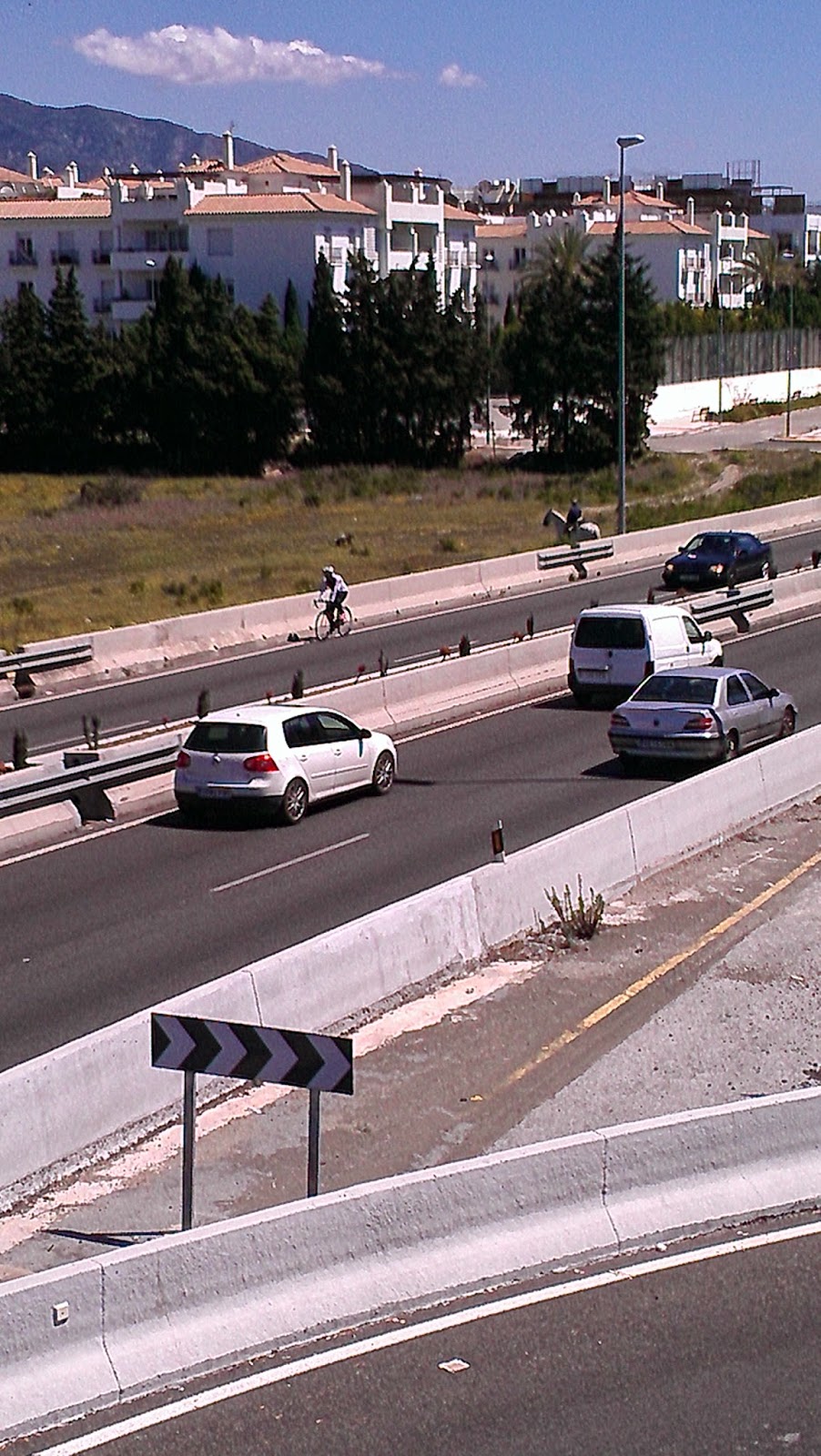 |
| after-school commute - on the overpass |
Thursday
11:30am - It's Friday! Well, at least for me. It's my last day of classes for the week. I arrive at the school just in time for my first of 2 math classes.
11:35am - 1:45pm - Back-to-back math classes with the 1st and 2nd year students. I already hate math. So having to 'teach' it in English to non-English speakers is not exactly my favorite activity. The profe usually has me work with the students using a prepared handout of exercises. I explain the instructions in English and help the students use English to read the equations and explain their solutions. Most of the time, it goes well, but there are some differences in the way math is done/taught in Spain (commas instead of decimals, methods for division, etc.) that leave me scratching my head. The math profe usually reverts to speaking completely in Spanish (an absolute no-no in my other classes) before the end of the class, so am I often left smiling and pointing like a mute game show host while secretly counting the seconds until class is over. Did I mention that I hate math?
 |
| but when it's one of the students' birthday, they do this - which makes math less awful. |
1:45 - 2:45pm - History and geography with the 3rd year students. A cool class since the students are older, and we often get into some pretty deep conversations. Today's topic: globalization. I lead the students in a brief discussion on how we have all been impacted by globalization. I ask them for examples of music, food, clothing, and TV programs that they like but are not from Spain. Then we do some reading and translation, and finally finish with a video that I found on the topic. The students give a huge round of applause after the video, and I spend the last few minutes of class having them share their opinions on why they think globalization is good or bad. When the bell rings, I get the feeling that all of us are sad that class is over.
Well, maybe not too sad.
surprising / annoying / amazing things about spain
surprising things about spain
how NOT amazing the food is.
The food in Spain is definitely not bad. But it isn't nearly as amazing as I'd expected it to be. Part of that could be because I live in Marbella, which isn't exactly hailed for its cusine. The other part could be that, given my teaching assistant's salary, I try not to eat out too much. When I do eat out, I go for the best value. Maybe if I could afford to splurge on some higher-end places, I'd have a different experience. But for now, I remain surprisingly underwhelmed.
 |
| pan con aceite y tomate. a typical spanish breakfast. when it's good, it's good. but usually it's just soggy bread. |
it's kind of country.
I live in Andalusia - the south of Spain. Among Spaniards, it has a pretty similar reputation to the South in the United States. Spanish people who live elsewhere seem to think Andalusians are 'slower' and have a funny-sounding accent. Even though I live in a fairly large city, it's quite common to see touches of rural life on a daily basis - like the horse-riding vaquero that grazes sheep, cows, and steers in a big field near my school. Also, I was surprised that much of Spain seems to be uninhabited. When I've flown or taken a long-distance train, I've seen large expanses of land that have no cities or towns to speak of - only the occasional pueblo / village or often just a small house or farm in the middle of nowhere.
 |
| cattle grazing near my school (and adjacent to a major highway) |
how cold the houses are in winter.
Before coming here, I knew that many Spanish houses lacked central heating, since most are built to be naturally cool during the sweltering summer months. But nothing could have prepared me for how cold it would be inside the average Spanish home from January to early March. Even when the temperature outside was Fall-like, the temperature inside was much chillier. With electricity being very expensive, space heaters are generally out of the question. And even if they weren't financially impractical, the lack of insulation, and the heavy use of marble, tile, and stucco for interiors would render them almost useless anyway. My #1 saving grace was a hot water bottle that my roommate wisely suggested I purchase, and was my nightly companion for my first two months here. There were many nights that I went to sleep muttering profanities under my breath about the cold, and many mornings where I could see my breath in front of me while getting ready for school. Thankfully, all that seems like a dim memory now that Spring is here.
 |
| i actually bought a space heater, but it ended up collecting dust once i found out how expensive and ineffective it was. |
 |
| my 'hot water bottle boo' in granada |
annoying things about spain
dog poo. everywhere.
Spanish people love their dogs. It seems like almost every family here has at least one. And every one of them is cuter than the last. Yet I have no idea why these people feel it's ok to let their cute little dogs leave unsightly poo all over public areas. If you're walking down the sidewalk, there's no such thing as absentmindedly taking in the sights around you. You'd better keep your eyes focused on the sidewalk or else you will definitely end up stepping in one of the many mini monuments of poo peppered all along your path.
 |
| poo |
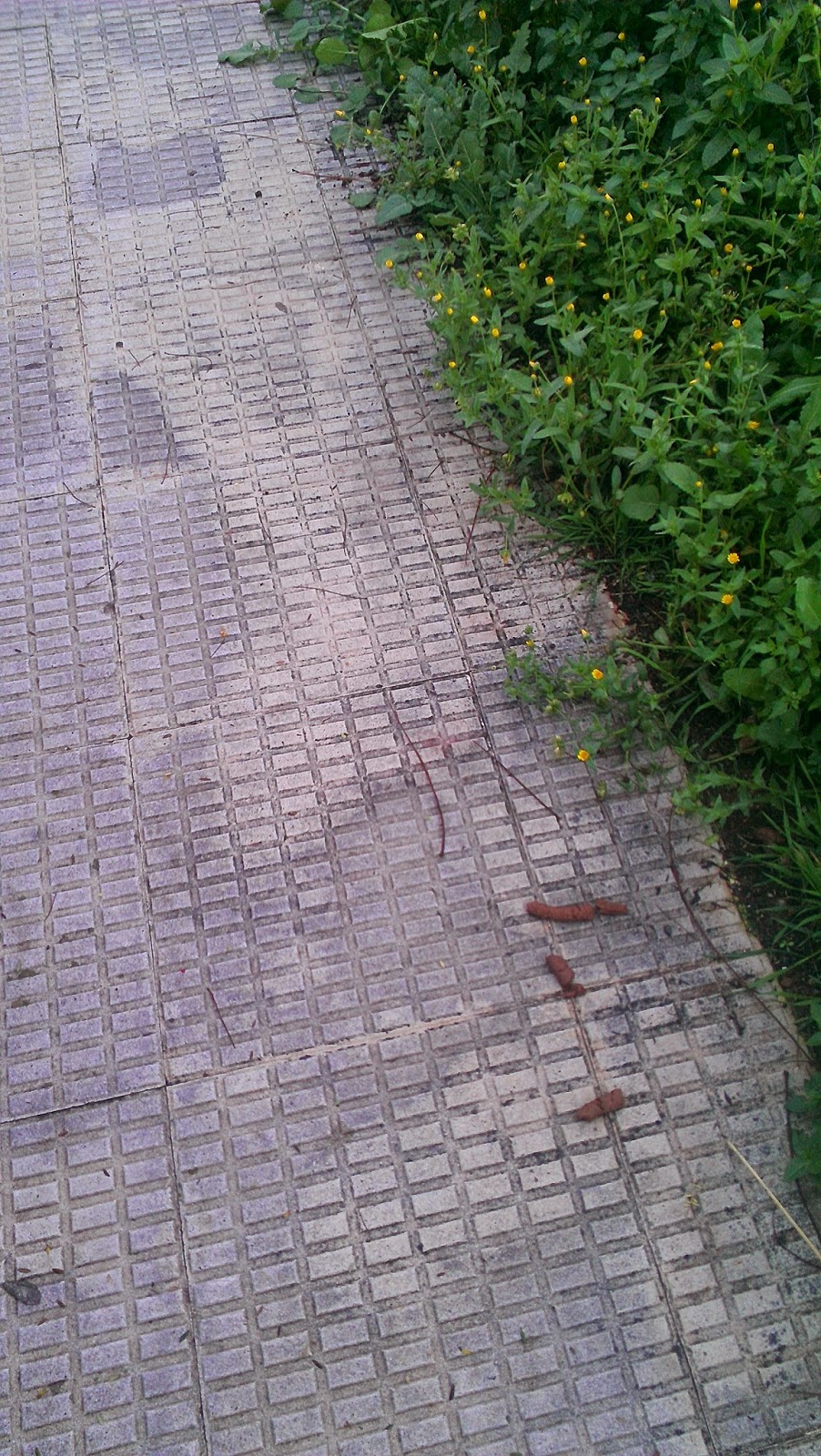 |
| poo |
 |
| and more poo |
spanish people can't walk. or stand. or generally congregate in large groups.
There are some cities where it's almost a pleasure to walk in. In crowded, pedestrian-heavy cities like New York, London, or even Amsterdam, most people have figured out how to navigate the streets on foot so well, that you can tell a tourist from a local by the way they walk. The folks in Spain have acquired no such talent. Spaniards don't walk so much as they meander. On a given day, while walking the streets of almost any city in Spain, at least one of the following pedestrian 'violations' are bound to occur:
- Stopping short for no apparent reason.
- Walking 3 or 4 abreast on a narrow sidewalk at a snail's pace.
- Darting out of a doorway into oncoming foot traffic.
- Tripping or hip-checking another pedestrian with a stroller or rolling bag.
- Having an involved conversation while blocking an entrance/exit.
- Doing 1 or more of the above without awareness or apology.
shhh... it's a secret.
There's a certain clandestine nature about vital information in Spain. Info that you would assume should be readily available or clearly communicated, often isn't, and if you don't ask specifically, you might only get a piece of the full picture. This secret but valuable info could be anything from a bus schedule or ticket price, to exact directions to a location you're looking for, or even what day you will get paid on.
amazing things about spain
there is no famine of beauty.
Geographically speaking, Spain pretty much has it all. Glittering beaches, impressive mountains, rolling countryside. And since there are those large expanses of unpopulated space, it makes for some really lovely, truly breathtaking vistas. I can't count how many times I've involuntarily whispered to myself, 'That's beautiful!' There are so many lovely natural and architectural sights in this country that sometimes I think to myself, 'Ok, Spain. Enough already! I get it. You're beautiful'.
the lifestyle.
In general, Spanish people are more relaxed than Americans about... everything. Sometimes, this can be irritating (as is the case with customer service), but for the most part, it's a huge plus. If there's one thing the Spanish are good at, it's enjoying life at their own pace. This is not to imply that the Spanish don't have worries or issues that they struggle with on a daily basis, but rather to highlight that there's not also a constant undercurrent of external stress from hectic schedules, long work hours, few vacations, and infrequent naps that they have to contend with. Besides that, most Spaniards seem to make the most of what they have, even if they only have a little. The often used Spanish phrase, 'no pasa nada', is the Iberian equivalent of 'no problem, mon' or 'no worries, mate', and it adequately sums up how many people here approach life.
the transportation.
Even without a car, it's incredibly easy to get around within a particular city, and especially between cities. The buses and trains within Spain are extremely reliable and comfortable. Way better than Amtrak and Greyhound in the States. High-speed trains can be a bit pricey if you're on a tight budget, but offer huge time savings. Buses are usually very affordable when travelling between cities, although they may not be the most convenient where timing is concerned. Yet both are clean, comfortable, and well-serviced. It sets the perfect stage for easy, affordable weekend excursions.
how amazing the food is.
While restaurant food underwhelms me, the quality and price of grocery store goods makes me very happy indeed. Mind you, I can't find everything that I'd normally cook with at home, but the produce and meat available here is of much better quality than in the US. And the prices for most non-packaged goods are comparable, if not much better. Especially the fish and seafood. Seriously, there are days when I just go to the seafood counter at the local grocery store and just drool. There's stuff there that I have absolutely NO idea how to cook, but I geek out just looking at it.
finding my place
It’s funny how things work out. Hardly ever like you expect them to, but almost always like you need them to. Well, I suppose that’s how my Spanish apartment search worked out. Before arriving, I’d pretty much put all my eggs in one basket. When I heard from Tonisha while I was back in the States, I was like, ‘Great! This is gonna be the best situation. Living with someone in the same program, who speaks English, and whose name is Tonisha… so she must be cool (yeah, ridiculous. I know).’ But, after I arrived, it seemed like her communication got worse and worse. I was starting to get the feeling that she was no longer interested, and that I should come up with some alternatives. So, I hit the interwebs and started looking for other roommates and rooms for rent. Not an easy task, given the on/off again nature of the wifi in my room. But, despite the difficulty, I managed to come up with a list of about 10 suitable places. I narrowed that list down to a ‘top 4’, and started making calls and sending emails.
Of course, due to my shoddy Spanish, I was really nervous about calling, but on my first one I stumbled a bit in Spanish, before asking if the person spoke English. She did, and we set a time to meet the following day. In the meantime, Tonisha got back in contact with me, plus, I heard back from a couple of other places. Secretly, I was hoping that I would meet with Tonisha and be completely done with the search, but I kept the other appointments just in case.
My first apartment showing was with an older lady within walking distance of San Pedro. I was a bit concerned about the place, since her ad mentioned that she lived with 3 dogs, but the price was right and she was pretty close to the beach… big plusses in my book. The room was a bit on the smallish side and she had another renter already in the place – a Polish girl who I didn’t get to meet during my visit – who I would have to share a bathroom with. After showing me around and explaining everything about the house and the neighborhood, my potential landlady’s tone of voice changed rather abruptly as she said to me, “I have just one rule for the house. No men. Ever.” What came out of my mouth was, “Ok.” But what was going on in my head was, “Girl, stahp. I’m grown! What if my boyfriend wants to come visit? I gotta find someplace else for him to stay? Sneak around like a high school virgin? Ain’t nobody got time for that.” I silently crossed ‘cheap beachy abode’ off my list of contenders.
My next visit was the next day with Tonisha. Like I mentioned before, I was sort of hoping we would meet, fall in love, and be best roomie-buds forever! Sadly, that was not the case. The place was nice and spacious, centrally located in a very cool area in the center of Marbella (about 7km from my school), but Tonisha’s whole demeanor seemed lackluster and really low-energy, almost ho-hum. I tried to engage her in conversation, “What do you do in your free time here?” “How’s your school / work situation?” “What kinds of things do you like to eat / cook?” But it seemed like so much effort to get an energetic response from her, and she asked me nothing in return. Plus, there was also the issue of a shared bathroom. As I left to head to my next viewing, I thought, “Well everyone has an off day. Maybe she’s still a bit tired from travelling back from the States.” I filed her in the ‘Maybe’ column.
I set off for my next appointment, which was a bit far from both my school and the center of Marbella, but I figured it would at least be good to see it for comparison purposes. After deboarding the bus, I started walking, using the directions that I was given by the potential landlady. Since the directions contained only loose landmarks (go past the Shell station, to the second roundabout, and take the 2nd exit), not street names, I quickly realized that I might be lost. I had already walked up 1 very long, steep hill, backtracked and walked up another. Since the weather was unseasonably warm, I’d once again broken a sweat and had to shed my blazer. After about 15 minutes of walking without any sight of the street or house I was looking for, I grumbled to myself, “I don’t care how nice this place is, I can’t live here. It’s too damned far!” I finally gave in and called the landlady, explaining that I’d gotten turned around. Thankfully, she was the one who spoke English, and after giving her a landmark, she said she knew exactly where I was and would come pick me up.
When Simin zoomed around the corner in her little car and stopped to pick me up, I don’t think either of us was exactly what the other one was expecting to see. But we instantly fell into easy, spirited conversation with each other. When we arrived at her house, I regretted my earlier statement about never being able to live here. The place was absolutely gorgeous. A traditional Spanish-style townhouse, with a whitewashed exterior, a nice little garden and a sunny, open terrace. Inside, Simin’s decorating style could best be described as hippie-chic. Nothing matched, but somehow everything worked. I instantly recognized some prints of Frida Kahlo, and noticed that many of her furniture choices were very similar to my own back home. And then, she showed me the room. It was huge! A queen-sized bed, writing desk, and a bookshelf with a closet that could easily be a whole ‘nother bedroom. And the cherry on top of it all? My own bathroom! As she showed me around the place, we continued our easy chatter – we discovered that we’re both into hiking and yoga, and she let me know that even though she was born in the area, she had just moved back after several years away and felt almost as new here as I did. As we wrapped up our conversation, I prepared to leave for my next and final showing. Simin volunteered to give me a lift to the place, since she was headed out in a few minutes. “How nice!” I thought.
The next place was literally a stone’s throw from the beach in Marbella. The apartment was shared by 2 or 3 students, and I would have my own room and bedroom. But when I entered, it definitely looked like students lived there. There was a mattress randomly thrown against the wall in the main living room, and the rest of the place looked like it had been decorated with somebody’s grandma’s leftover furniture. The oven in the kitchen didn’t work, and the sink was full of dishes. There was an absolutely amazing terrace, though. And I would have direct access to it from my room. Still, I knew I wouldn’t be able to live comfortably in the dorm-like environment. I crossed it off the list.
Slightly exhausted from all the walking and viewing, I decided to take a quick break at the beach to mull over my options. In my mind, I really only had Tonisha and Simin to choose from. While sitting and soaking in the sun, I recalled the prayer I’d said before setting out on the hunt today. I’d asked God to help me find a place that felt like home. After a quick phone chat with Bro. Johnson, I dialed a number.
“Hola, Simin! It’s Kisha.”
“I don’t think I’m going to find a place that’s a better fit than yours. If it’s ok with you, I’d like to take the room.”
-------------
Pics of my new place:
 |
| my roommate, simin |
first impressions
As of last night, my official assessment of San Pedro was, “I effin’ hate this place.” But, honestly, I think I just got so spoiled by the grand elegance of Seville that I couldn’t appreciate it. It’s definitely small, and it seems to be just a little bit ‘hood. Plus, the street system is like a big pile of tangled spaghetti. Hardly any street runs in a straight line, and a street will change names without warning, so it’s ridiculously easy to get lost or turned around, even with a map.
 |
| if it weren't for the friendly name on this building, i would never have found my room again. |
Also – I think my assessment was severely tainted by a piece of graffiti that I saw on my walk. Scrawled on a wall in the middle of an empty plaza were the words, ‘No Moros’, along with a faded red swastika. Needless to say, it made me very uneasy and equally pissed off. Even on the other side of the world, the ugly spectre of racism cannot be escaped. I tried to put the image out of my mind, but it stayed with me (subconsciously) for the rest of the day, ‘cause I remained in kind of a bad mood. I’m already sensitive and aware of how conspicuous I am walking around such a small town; I really could have done without that.
Anywho, I’m on the bus to Marbella now, it’s a much prettier and warmer day than yesterday, and I’m hoping to get a better look at things. I may even meet up with Tonisha (potential roomie) as she finally got back in touch with me today.
 |
| view from the edge of town |
 |
| plaza de la iglesia - at night |
 |
| plaza de la iglesia - day |
 |
| avenida marques del duero - runs through the center of san pedro |
 |
| how'd they know i was here? |
lo perdí (i lost it)
 |
| subject to change. ain't THAT the truth! |
My flight to Spain should have been uneventful. But one tiny noob mistake turned an uneventful trip into something of a ridiculous saga.
The Realization
Maybe it was the excitement, maybe it was the jet lag, maybe it was meant to be, or maybe I’m just a bit daft. Whatever the reason, I managed to deboard the plane at my first connection point in Paris and leave my passport behind in my seat. How the hell I did something so ridiculously stupid, I’ll never understand, but I’ll probably be a long time forgetting the repercussions, namely, an extra 6 hours tacked on to an already long journey.
Once I’d discovered that I’d left my passport, I hurried to the airline help desk to see if I could get someone to quickly check the plane for my missing travel document. I explained my predicament to the desk clerk. She called the gate, spoke to someone in rapid-fire French (half of which I understood), and then hung up, turning to let me know that they were checking and would call back. When they did a few moments later, she relayed the message in heavily-accented English, “They deedn’t find eet.” WHAT!? Oh, Jesus, no. This is not happening. Of all the f*(#@n things to lose, I lose the 1 things that I barely got back in time for the trip!? This. is NOT happening.
I fought back encroaching tears and pleaded with the desk agent. “I know it’s there,” I explained. “I have been nowhere else, not even to the bathroom. I’ve already checked every inch of my bag, and nothing! And, I remember putting it on the seat next to me when I sat down.” She reconfirmed my seat number with the person on the phone, waited. “No,” she said. They saw nothing. At that moment, still fighting back tears and resisting the urge to cuss my own self out for being so careless, I just started praying under my breath. “God, I need you to come through for me. I know this can be resolved. I know you will help me find a way to resolve this. I know this cannot be how this is supposed to turn out - me, stuck in a Paris airport, unable to reach my destination.” Just then, the desk agent offered the only other suggestion she had, “Haff you reported eet to the police?” “No,” I said. She suggested I do so and pointed me in the direction of the airport police office.
The Station
So, at just past 5am, I find myself communicating my situation to a French policeman as best I can. He is listening as best as he can, standing behind an unnecessarily tall desk. I am eyeing both his face for the appropriate level of understanding, and the face of the clock on the wall next to me, noticing the minutes dwindle along with my chances of making my connecting flight. After communicating my issue, I am told to wait a few moments. I briefly consider taking a seat among the dozens of others waiting on uncomfortable-looking chairs, but I decide that standing in direct eyesight is the better choice. Much conversation transpires in French among the 2 or 3 officers gathered behind the desk. One, the most genial and the one who I have just talked to, seems to be pleading my case to another more stern, apparent authority-figure who seems to be rapid-firing back the appropriate protocol to Msr. Genial. Msr. Autorité appears totally unsympathetic to the silly, simpering American woman looking on helplessly at their conversation. I don’t think he even makes eye contact with me. A third officer stands by, mostly watching the exchange, his body and facial language seemingly saying, ‘Damn. That sucks. But I don’t want to get involved in this mess.’
After a few stomach-churning minutes, an officer approaches (was he 1 of the previous 3? In my flustered state, I really can’t tell.). He speaks to me in English, “Follow me.” I do.
"Have you asked the desk agent?"
"Yes," I say. "She called the gate and said they found nothing, but I know it’s there,” I tell him.
We go back to the help desk, this time to a different agent. She phones the gate again, gives the same details as before, listens, then speaks something in French to the officer. He turns to me. “They found it.”
YES!
A flood of relief washes over me. I notice that the previous agent gives a pinched look. What was that all about, I briefly wonder. But I have no time to pontificate. Officer Helpful is writing down the gate number, and escorting me back to pick up my passport.
The Reclamation
I chalked up the fact that no one really seemed rushed at all, or offered any help in getting me to my connecting flight to French / European standards of service or their overall lack of urgency about things. Still, I was hoping there would be a sliver of a chance for me to make it, as long as I moved very, very quickly. Well… I did move quickly, but the airport tram, the gate workers (who where nowhere to be found when me and Officer Helpful arrived. Really!? We just called and said we were coming. WTF?), and everyone else in the airport were not on the same page. After Officer Helpful had retrieved my passport and given it back to me (he also had to take a pic for his report), I dashed back through the airport terminal, on the tram again, then a quick customs stamp, a thorough undressing at security screening, and by that time I saw flashing on the monitors that the status of my connecting flight was:
Boarding - Last Call
I broke into a run, with my shoes barely zipped and my belt barely back on, and my approved carry-on liquids barely stuffed back into my bag.
Now, I’m already not a runner, but after an 8-hour flight with spotty sleep, a stressful ordeal and with a kinda-heavy carryon in-tow, I’m pretty sure I looked like the most awkward, disheveled, panicked, banshee-woman that Charles de Gaulle airport had ever seen. I was sweating, and panting, and thinking of stopping, but I had to push… just in case. When I made it to the gate, it was immediately clear that I was too late… by about 7 minutes.
Final Destination
I asked the gate agent what my options were and she pointed me to the AirFrance info counter just a few feet away. I approached, explained my situation, and asked what could be done. I was preparing for the worst - an extra fee, no more flights / seats available, etc - but hoping for the best. After a helluva lot of click-clacking, typing, sighing, and conferring with her manager, Mme. Info Desk uttered my new favorite French word, “superb!” And I was all set with a new ticket with no extra fees. My next leg would take me from Paris to Madrid, and the final flight would leave from Madrid to Seville… about 6 hours afterwards.
Though I was happy that I hadn’t totally screwed myself, I was completely dismayed at the idea of having to wait in another airport for hours. Plus, now that I would be arriving late, it meant I’d have to find my own way from the Seville aiport to the hotel (instead of taking the free shuttle provided by my program), and that I would likely miss the first part of orientation.
I was exhausted, disheveled, and it appeared that my too-thick socks combined with my too-tight new boots, along with all the running and walking had resulted in a painful blister on the back of one heel. Any hopes of arriving cool, calm, and collected were long gone.
By the time I finally boarded the flight to Seville, I was an irritated lump of sweaty, achy, tired flesh, and I still faced the possibility that my luggage might not be waiting upon my arrival. Fortunately, it was, and I sailed out of the Seville airport as quickly as I could, caught a cab to the hotel, and vowed never to repeat such a ridiculous mistake or experience again.

































.jpg)
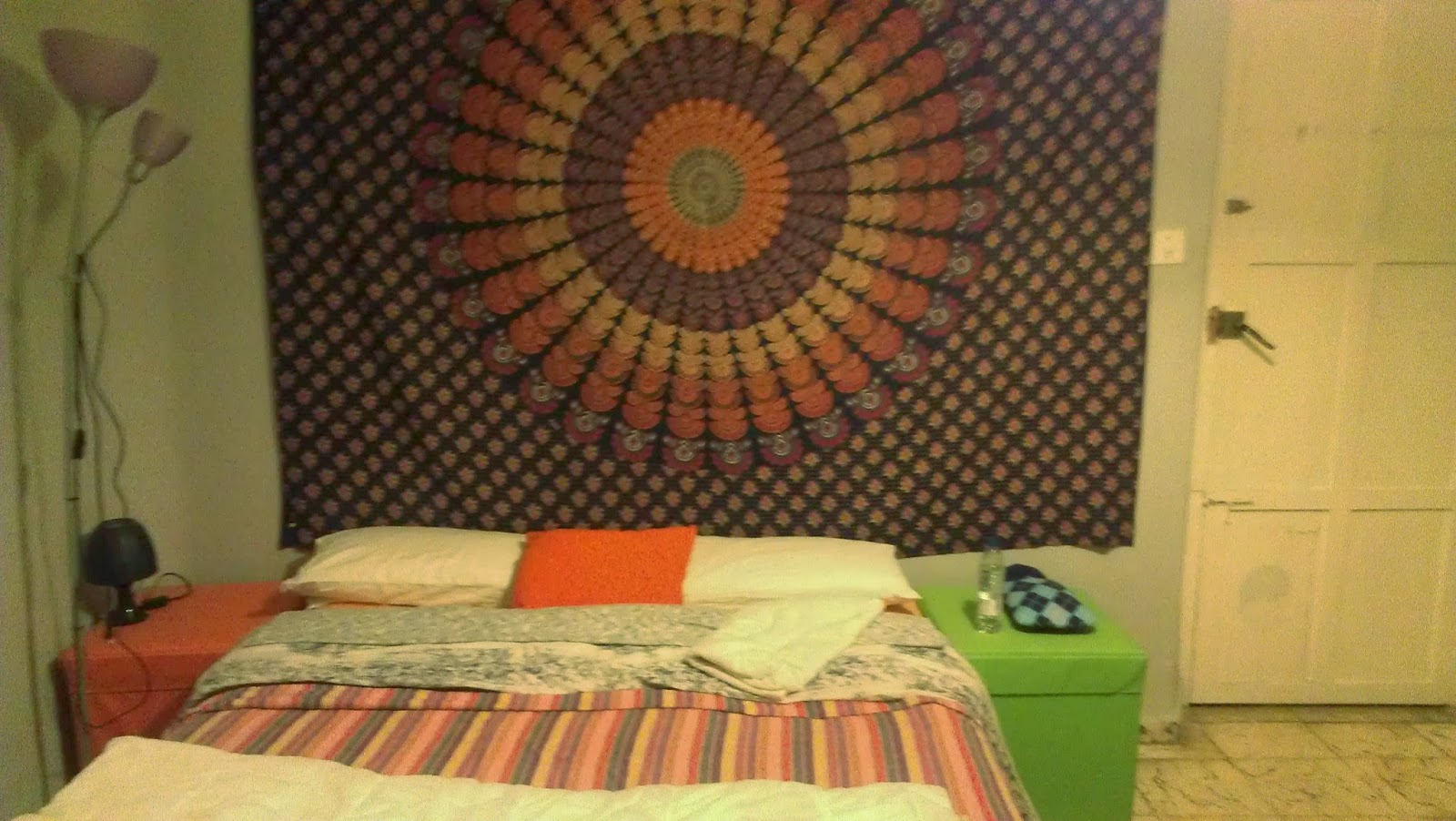.jpg)
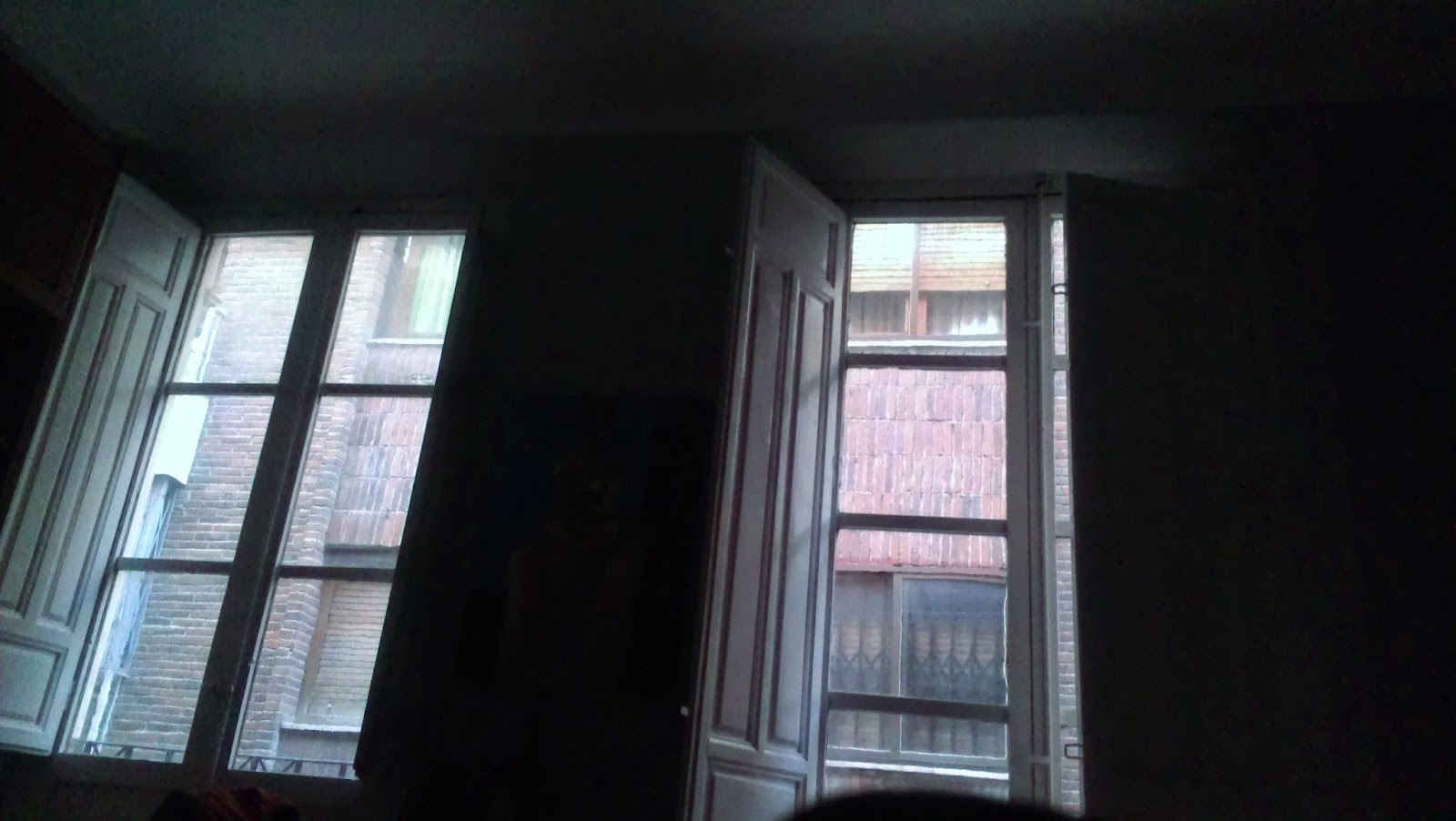.jpg)
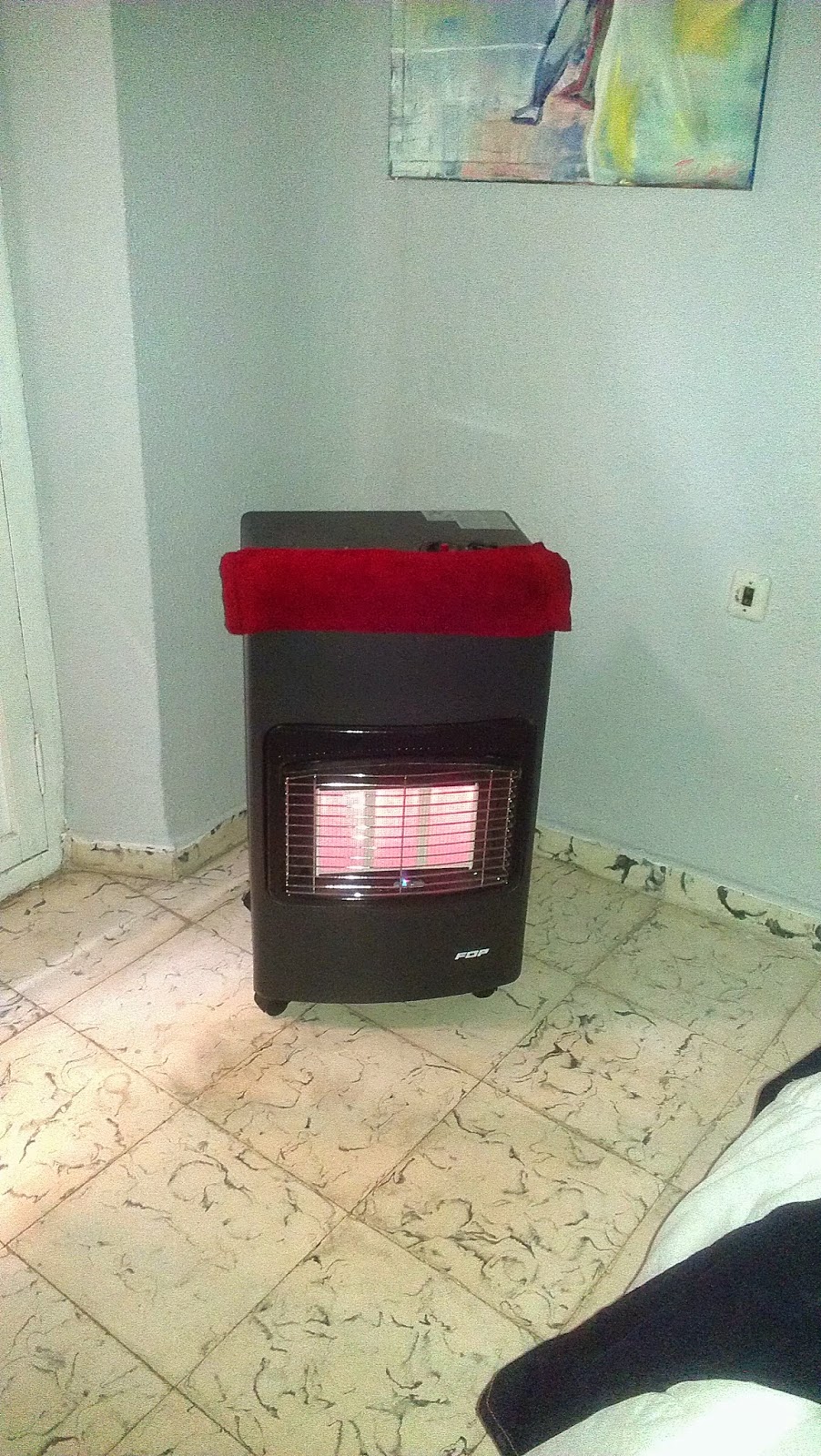.jpg)
















































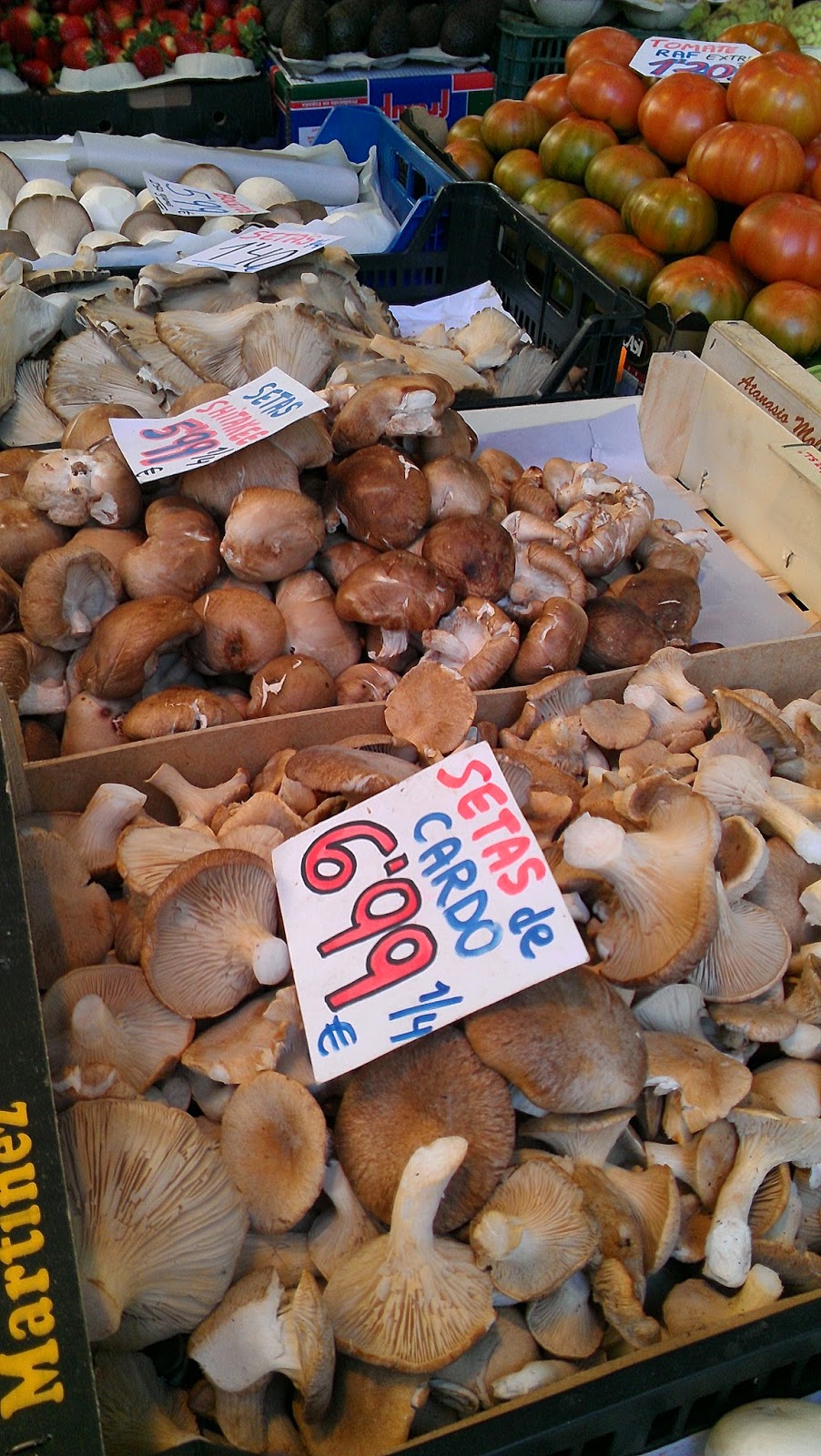.jpg)

.jpg)

.jpg)
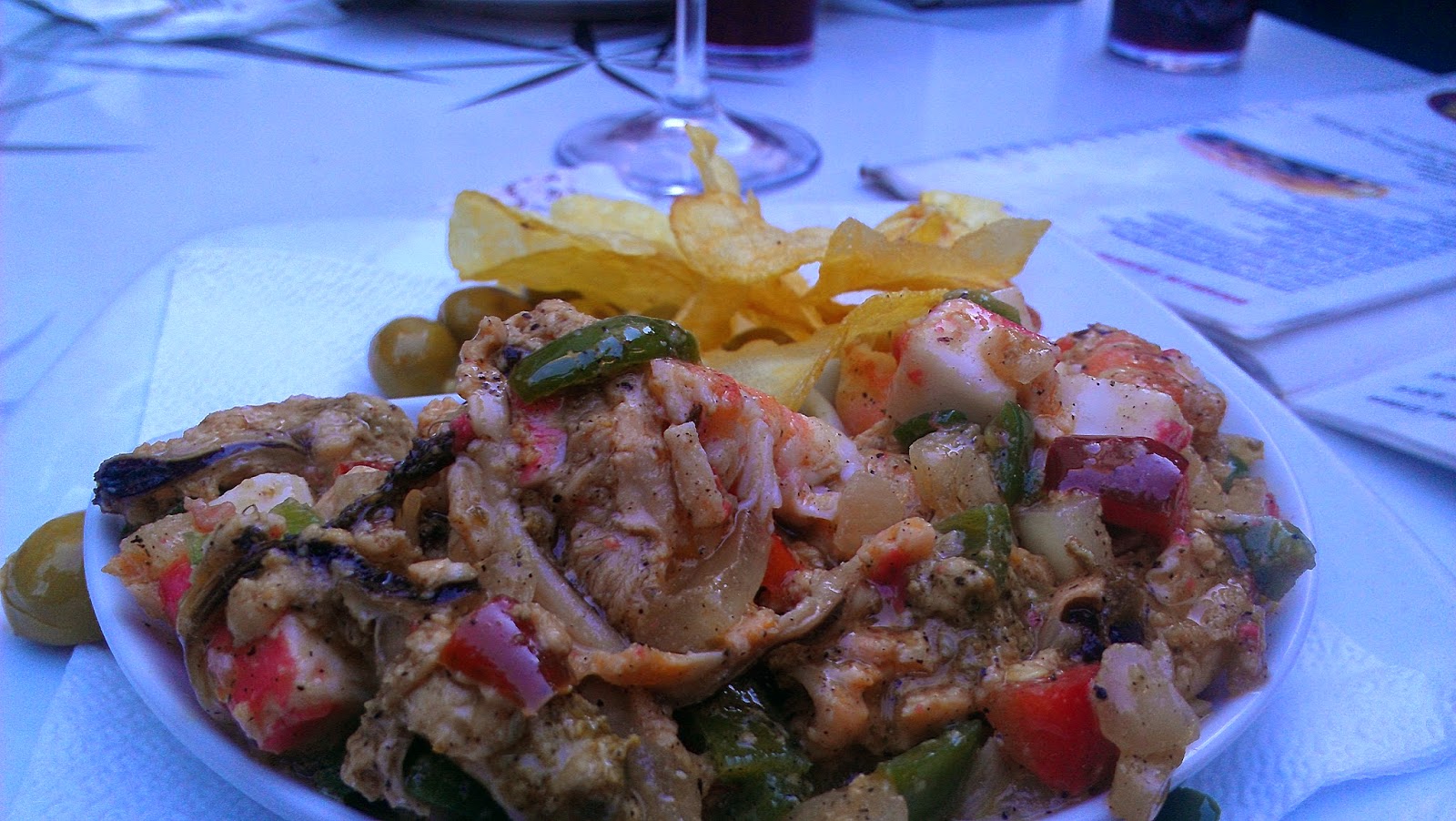.jpg)
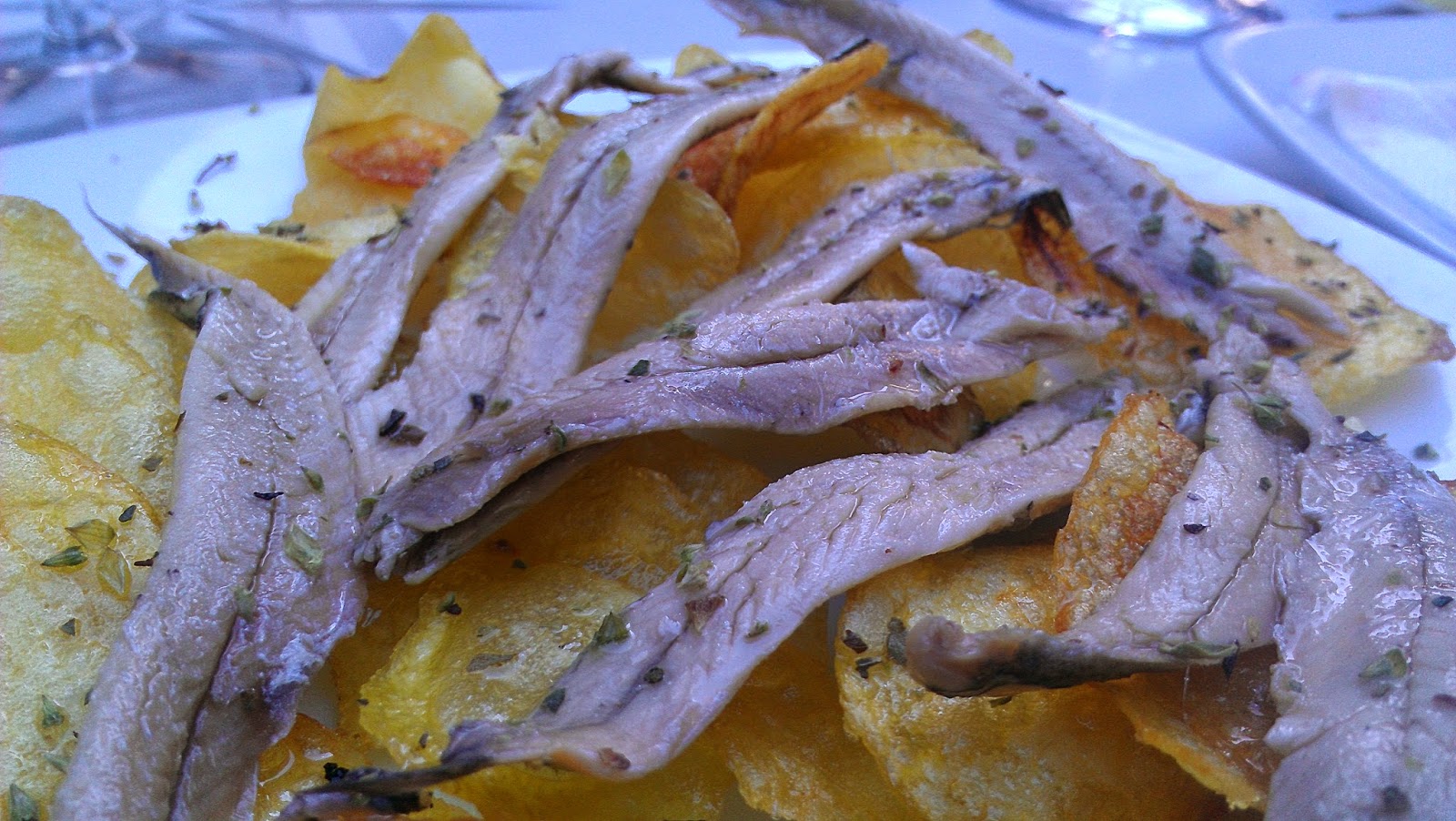.jpg)

.jpg)
.jpg)
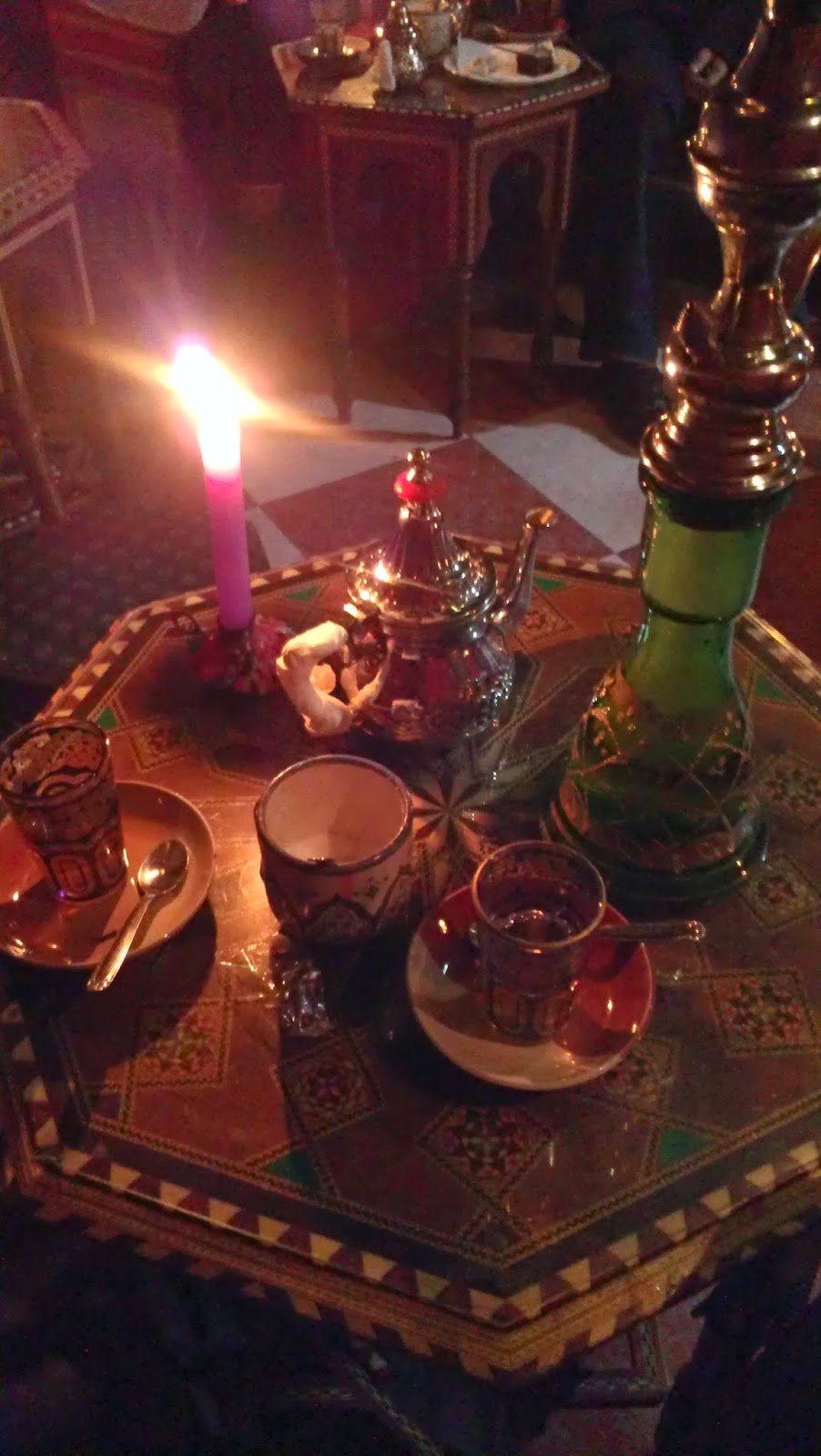.jpg)

.jpg)
.jpg)
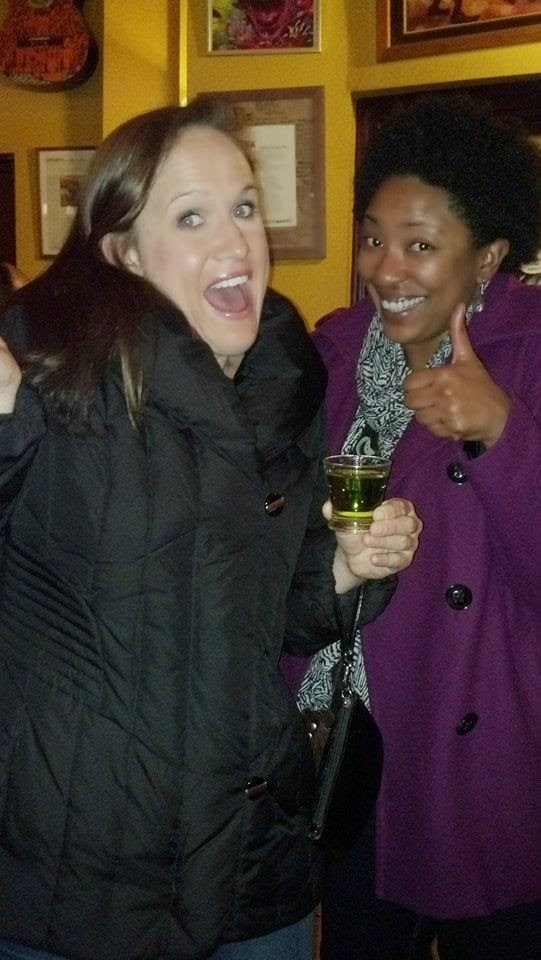.jpg)
.jpg)











